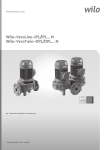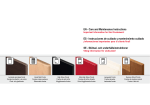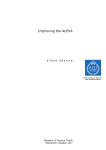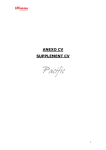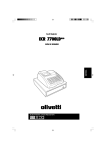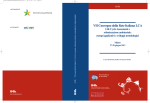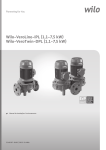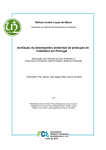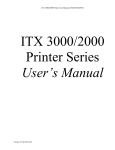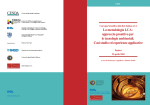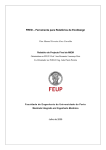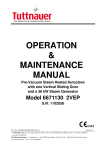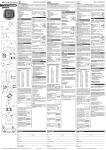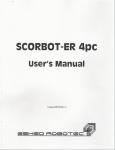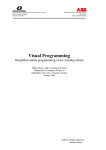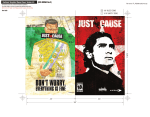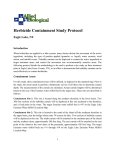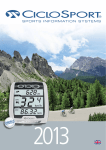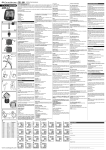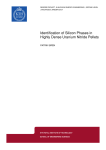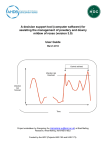Download fulltext - DiVA Portal
Transcript
Implementation of ecodesign tools to evaluate and improve the environmental performance of a semi-automatic espresso machine MAGNUS WESTERDAHL Master of Science Thesis Stockholm, Sweden 2012 Implementation of ecodesign tools to evaluate and improve the environmental performance of a semiautomatic espresso machine Magnus Westerdahl Master of Science Thesis MMK 2012:56 IDE096 KTH Industrial Engineering and Management Machine Design SE-100 44 STOCKHOLM Preface The master thesis that you are now holding in your hand concludes my five years of studying to become an engineer at the Royal Institute of Technology, KTH, in Stockholm. My subject has been Design and Product Realization which is a traditional education in mechanical design with elements of industrial design. One thing that has interested me in particular during my studies is how to design products with as low environmental impact as possible, a field commonly referred to as ecodesign. In the autumn of 2011 I first came in contact with the company Crem International. Crem manufactures and sells coffee machines and had for some time been interested in the environmental aspects of their machines. Our common interest in this area resulted in the first early draft that later were to become this master thesis. At the time of writing I look back at 20 weeks of hard and inspiring work. It has been quite a journey and I hope you will find the end result just as interesting as I do. There are a number of persons I would like to thank for their much appreciated help during the writing of this thesis. Without the following people this thesis would not have been possible to complete. First of all I would like to thank my supervisor at Crem International, Peter Larsson. Without his help thesis would simple not have been possible to realize. Despite his hectic schedule Peter always took his time to make you sure that I had everything that I needed to do the job. Many thanks also goes to my supervisor at KTH, Conrad Luttropp, whose solid knowledge and long experience of ecodesign has been of great value during the entire length of this work. Conrad was always available whenever difficulties arose and provided much appreciated guidance and support. I would also like to thank all the employees of Crem International whom have been very helpful in answering all of the enquiries that I have had working with this thesis. I also thank the people at Swerea IVF and Hans-Lennart Norrblom in particular for all their advice and assistance. Additional thanks also go out to all the professional espresso machine users whom took their time to participate in the user study. Magnus Westerdahl Stockholm, August 2012 Examensarbete MMK 2012:56 IDE096 Implementering av ekodesignverktyg för att utvärdera och förbättra miljöprestandan hos en semiautomatisk espressomaskin Magnus Westerdahl Godkänt Examinator Handledare 2012-10-01 Conrad Luttropp Conrad Luttropp Uppdragsgivare Kontaktperson Crem International Peter Larsson Sammanfattning Miljöfrågor är av ökande betydelse för företag idag. För ett företag i tillverkningsindustrin erbjuder ekodesign ett sätt att förbättra företagets miljöprestanda genom att mäta och minska miljöpåverkan från företagets produkter. Crem International tillverkar och säljer kommersiella kaffemaskiner för café-, restaurang-, hotell- och kontorsbruk. Företaget är i färd med att utveckla en ny energieffektiv halvautomatisk espressomaskin och önskar utvärdera produktens miljöprestanda med fokus på energianvändningen. Syftet med detta examensarbete är att tillhandahålla en sådan utvärdering. Studien börjar med att undersöka vilka ekodesignverktyg som finns tillgängliga för att kunna hitta en lämplig metod att använda vid genomförandet av miljöutvärderingen. Den slutsats som dras är att en kombination av ekodesignverktyg behövs för att framgångsrikt utföra analysen. De tio gyllene reglerna för ekodesign används som ramverk för arbetet. En förenklad LCA utgör grunden för energiutvärderingen och en demonteringsanalys utförs för att utvärdera produkterna sluthanteringsegenskaper. Resultatet av studien visar att den största miljöpåverkan från maskinen kommer från dess användning. Den elektricitet maskinen använder för uppvärmning står för den i särklass största miljöpåverkan. Studien visar att den nya maskinen använder 38% mindre energi än en tidigare modell och att användaren kan påverka energianvändningen i stor utsträckning, t.ex. genom att aktivera maskinens energisparläge. För att förbättra produkterna miljöprestanda rekommenderas att företaget fortsätter arbetet med att förbättra produktens energieffektivitet. Detta kan göras genom fortsatt arbete med termisk isolering och genom att förse produkten med ett aktivt energisparläge. Det rekommenderas också att företaget implementerar ekodesignverktyg i dess produktutvecklingsprocess så att ytterligare miljöförbättringar kan uppnås och mätas. Examensarbete MMK 2012:56 IDE096 Implementering av ekodesignverktyg för att utvärdera och förbättra miljöprestandan hos en semiautomatisk espressomaskin Magnus Westerdahl Godkänt Examinator Handledare 2012-10-01 Conrad Luttropp Conrad Luttropp Uppdragsgivare Kontaktperson Crem International Peter Larsson Sammanfattning Miljöfrågor är av ökande betydelse för företag idag. För ett företag i tillverkningsindustrin erbjuder ekodesign ett sätt att förbättra företagets miljöprestanda genom att mäta och minska miljöpåverkan från företagets produkter. Crem International tillverkar och säljer kommersiella kaffemaskiner för café-, restaurang-, hotell- och kontorsbruk. Företaget är i färd med att utveckla en ny energieffektiv halvautomatisk espressomaskin och önskar utvärdera produktens miljöprestanda med fokus på energianvändningen. Syftet med detta examensarbete är att tillhandahålla en sådan utvärdering. Studien börjar med att undersöka vilka ekodesignverktyg som finns tillgängliga för att kunna hitta en lämplig metod att använda vid genomförandet av miljöutvärderingen. Den slutsats som dras är att en kombination av ekodesignverktyg behövs för att framgångsrikt utföra analysen. De tio gyllene reglerna för ekodesign används som ramverk för arbetet. En förenklad LCA utgör grunden för energiutvärderingen och en demonteringsanalys utförs för att utvärdera produkterna sluthanteringsegenskaper. Resultatet av studien visar att den största miljöpåverkan från maskinen kommer från dess användning. Den elektricitet maskinen använder för uppvärmning står för den i särklass största miljöpåverkan. Studien visar att den nya maskinen använder 38% mindre energi än en tidigare modell och att användaren kan påverka energianvändningen i stor utsträckning, t.ex. genom att aktivera maskinens energisparläge. För att förbättra produkterna miljöprestanda rekommenderas att företaget fortsätter arbetet med att förbättra produktens energieffektivitet. Detta kan göras genom fortsatt arbete med termisk isolering och genom att förse produkten med ett aktivt energisparläge. Det rekommenderas också att företaget implementerar ekodesignverktyg i dess produktutvecklingsprocess så att ytterligare miljöförbättringar kan uppnås och mätas. Nomenclature Abbreviations NGO Non-Government Organization SME Small-Medium Sized Enterprise DfE Design for Environment EU The European Union ISO International Organization for Standardization LCA Life Cycle Assessment CAD Computer Aided Design 10GR Ten Golden Rules of Ecodesign LiDS-wheel Lifecycle Design Strategies Wheel ECM Eco-Design Checklist Method MET-matrix Materials, Energy, and Toxicity Matrix BOM Bill of Materials EVA-EMP European Vending Machine Association – Energy Measurement Protocol UNEP United Nations Environmental Program LCI Life Cycle Inventory ELCD European Life Cycle Database USLCI The United States Life Cycle Inventory Database CED Cumulative Energy Demand GWP100 Global Warming Potential over 100 years Table of Contents 1 2 3 Background ........................................................................................................................ 1 1.1 Ecodesign..................................................................................................................... 1 1.2 The Company .............................................................................................................. 1 1.3 The Product.................................................................................................................. 1 1.4 The Context of the Product .......................................................................................... 2 1.5 Goal and Scope ............................................................................................................ 3 Theory ................................................................................................................................ 5 2.1 Research Methodology ................................................................................................ 5 2.2 Research Results .......................................................................................................... 5 2.3 Research Conclusions .................................................................................................. 7 Methodology ...................................................................................................................... 9 3.1 Choice of Ecodesign Tools .......................................................................................... 9 3.2 Delimitations and Simplifications ............................................................................. 10 3.3 Data Gathering ........................................................................................................... 10 3.4 Environmental BOM ................................................................................................. 10 3.5 Disassembly Assessment ........................................................................................... 11 3.6 Simplified LCA ......................................................................................................... 13 3.6.1 Functional Unit ................................................................................................... 13 3.6.2 Life Cycle Scenario and Flow Chart .................................................................. 13 3.6.3 Life Cycle Inventory Analysis ........................................................................... 15 3.6.4 Sensitivity Analysis ............................................................................................ 16 3.6.5 Comparison to a Previous Model ....................................................................... 17 3.7 4 Results .............................................................................................................................. 21 4.1 Environmental BOM ................................................................................................. 21 4.2 Disassembly Assessment ........................................................................................... 22 4.3 Simplified LCA ......................................................................................................... 25 4.3.1 Sensitivity Analysis ............................................................................................ 29 4.3.2 Comparison to a Previous Model ....................................................................... 30 4.3.3 Energy Declaration ............................................................................................. 31 4.4 5 Environmental Assessment Matrix ............................................................................ 17 Environmental Assessment Matrix ............................................................................ 31 Analysis ............................................................................................................................ 33 6 5.1 Environmental BOM ................................................................................................. 33 5.2 Disassembly Assessment ........................................................................................... 33 5.3 Simplified LCA ......................................................................................................... 33 Discussion ........................................................................................................................ 35 6.1 Interpreting the Results .............................................................................................. 35 6.1.1 Environmental BOM .......................................................................................... 35 6.1.2 Disassembly Assessment.................................................................................... 35 6.1.3 Simplified LCA .................................................................................................. 35 6.2 How to Use the Study and the Results ...................................................................... 36 6.3 Suggestions to Improve the Environmental Performance of the Machine ................ 37 6.3.1 Improvements of the Machine ............................................................................ 38 6.3.2 Ideas for Future Improvements .......................................................................... 38 6.3.3 Ideas for Improving the Product System ............................................................ 39 7 Conclusion ........................................................................................................................ 41 8 References ........................................................................................................................ 43 9 Appendix .......................................................................................................................... 46 Appendix 1 – Online LCA Tools Appendix 2 – Company Survey Appendix 3 – User Study Appendix 4 – Environmental Bill of Material Appendix 5 – Disassembly Assessment Appendix 6 – Life Cycle Inventory Appendix 7 – Environmental Assessment Matrix Appendix 8 – Energy Declaration 1 Background The background to the thesis is presented in this chapter. The ecodesign concept is clarified followed by a description of the company, the product and the context of the product. The goal and scope of the thesis is stated at the end. 1.1 Ecodesign Environmental issues are a growing concern worldwide today. The world faces several critical environmental problems that require our immediate attention. A few examples of these are global warming, energy and resource depletion and human and ecosystem toxification. In response to this are governments, consumers, employees, NGOs and other stakeholders putting an ever increasing demand on companies to disclose and lower their impact on the environment. To meet these demands companies may adopt several different strategies. For a company in the manufacturing industry one such strategy is the concept of ecodesign. Ecodesign is defined in a variety of ways in the literature and the word is used in many different contexts. Karlsson and Luttropp [1] states that the ecodesign concept “focuses on the integration of environmental considerations in product development”. Using this definition means that the concept is very similar to that of design for environment (DfE) or sustainable design. In conclusion ecodesign and its associated tools can be regarded as a way for companies to assess and reduce the environmental impact of its products. 1.2 The Company Crem International is a manufacturing company offering commercial coffee machines for café, restaurant, hotel and office use. The company operates on the global market with branches in Sweden, Spain, China and England. The company has 250 employees and an annual turnover of 450 MSEK. Coffee Queen and Expobar are the company’s two major brands. The company has over the last years shown an increasing interest in ecodesign. A previous cooperation with the Swedish research and development institute, Swerea IVF, resulted in new ways of thinking regarding product design. One concrete outcome of this was an energy declaration of one of the company’s fully automatic coffee machines. This initiative received much positive response both from within the company and from the company’s customers. Additional motivation to continue to work with ecodesign is imposed by the company’s wish to take a proactive approach to new EU regulations that is likely to affect its products in the near future. Although the company has a positive attitude towards ecodesign there is yet no framework or tools in place to implement this issue in the product development process. The company is still investigating means to incorporate ecodesign in their daily work. 1.3 The Product A new semi-automatic coffee machine, the Pac Man, is being developed with ecodesign concepts in mind. One goal with this appliance is to set a new standard on environmental performance for this product type. The Pac Man is a commercial espresso machine intended for professional use in cafés, bars and restaurants. It is a midrange model aimed to satisfy a market with a medium to high 1 request of capacity and design. The Pac Man comes in different models and the model used for this assessment is a 2 group machine with an 11 liter boiler. The machine is powered through a three phase electrical outlet and has a rated power of 3500 W. Environmental improvements over previous models includes thermal isolation of the water system, a reduced use of brass components containing a high amount of lead and a more efficient heat control system. The machine is also equipped with a manual energy saving mode that can be programed to partially turn off the machine when it’s not in use. An example of a similar machine is shown in Figure 1. Figure 1 A similar semi-automatic espresso machine The primary function of the Pac Man, or any other semi-automatic espresso machine, is to deliver pressurized hot water for brewing espresso and steam for frothing milk that is added to many espresso based drinks. Secondary functions are to provide hot water for tea and heat to warm the espresso cups usually stored at the top of the machine. Without a warm cup the espresso will cool off too quickly when served resulting in a substandard drink. This is due to the small amount of liquid, usually 2-4 cl, which makes up an espresso. The brewing group and filter is also heated to keep the water from cooling off during the brewing process so that the optimal brewing temperature can be maintained. 1.4 The Context of the Product A coffee machine is a part of a larger system where the final product is one cup of coffee. The manufacturing and use of the coffee machine is an integrated part of the larger lifecycle of a cup of coffee explained in Figure 2. 2 • Cultivation and irrigation • Treatment • Packageing and delivery Processing • Roast and ground coffee processing • Packageing and distribution • Coffee machine manufacturing • Cup manufacturing Use Coffee equipment manufacturing Green coffee • Waste treatment • Brewing • Serving • Washing End of life Figure 2 The life cycle of a cup of coffee During its entire lifecycle coffee causes a wide range of environmental impacts. A study by Humbert et al [2] shows that roughly one third of the energy use and one third of the impact on global warming originate from the process of brewing coffee. This is mainly caused by energy used by the coffee machine for heating. This conclusion is supported in an additional study by Brommer et al [3]. The studies also show that the usage of energy is strongly dependent on the user’s behaviors. The manufacturing of the coffee machine itself only constitutes for a small percentage of the total impact from one cup of coffee. It shall however be made clear that both of these studies are conducted on coffee machines for home use. This shows that the life cycle impact of a coffee machine has a significant importance on the total life cycle impact of one cup of coffee. This, in turn, proves the importance of assessing and improving the environmental performance of coffee machines. However it also clearly points out that the coffee machine only is a part of the total environmental impact of coffee consumption. 1.5 Goal and Scope This thesis aims to assess the environmental performance of the Pac Man semi-automatic coffee machine that is under development by Crem International. The assessment considers the entire life cycle of the product from a cradle to grave perspective. The assessment investigates most major environmental aspects of the product however particular attention is given to the energy use during the machines life cycle. As a result a quantitative energy declaration is a part of the end result. The energy declaration is also compared to that of a previous model that will act as a reference. Besides investigating the products environmental performance the thesis also aims to give inspiration to how the company may work with ecodesign in the future. This study is limited to the part of the lifecycle of coffee that can be directly affected by the coffee machine manufacturer. This means that this assessment concerns the coffee machine itself and will as such not consider consumables associated with making a cup of coffee. Coffee, water, milk, sugar and such is thereby excluded in this study. Furthermore, it is beyond the scope of this thesis to provide guidance on how to implement ecodesign strategies in the company. However the author hopes that the thesis may provide inspiration to such work in the future. 3 4 2 Theory The methodology, the results and the conclusions of the research on ecodesign tools and techniques is presented in this chapter. 2.1 Research Methodology Initially a bibliographic review of current published material on ecodesign tools, techniques and case studies is conducted. The sources included in this review are peer-reviewed journals, internet pages, books, international standards and government documents. The purpose of the review is to find appropriate tools and techniques to be used when analyzing the coffee machine. It is also of interest to learn from previous case studies with similarities to this one. The bibliographic review is conducted using three online search tools that are listed below. Two research questions are used in the review and these are then broken down into search terms. Both research questions and search terms are listed below. Research questions: Which ecodesign tools are currently available? Which of these tools have been most successfully implemented by small-medium sized enterprises (SMEs) in previous projects similar to this one? Search terms used: Eco-design, ecodesign, sustainable design, design for environment, DfE, environmental design, ecological design, sustainable engineering, green design, design for sustainability, tool(s), metric(s), methodology(ies), evaluation, assessment, small medium sized enterprise, SME(s), small medium sized business, SMB(s). Research tools used: KTHB Primo [4] The Library of the Royal Institute of Technology’s search tool for accessing the library’s full collection of online and print material. Libris [5] A search tool for accessing printed and electronic material on Sweden’s scientific libraries and certain public libraries. Google Scholar [6] Google Inc.’s search tool for accessing scholar material available online. 2.2 Research Results A great number of ecodesign tools are available for use when assessing the environmental performance of a product. Attempts to list and classify theses tool have been made by a number of authors. Bovea and Pérez-Belis [7] provides the most recent one and another good compilation can be found as a part of Byggeth and Hochschorner’s [8] study. Different tools are intended for different purposes and different stages of the products life cycle. Some focus on the assessment only and some only on finding improvements, where others try to incorporate both. Some tools use a quantitative approach and others use a qualitative. Tools are also available that incorporate both types of data. Pochat et al. [9] includes an attempt to cover the different classifications made by various authors. A selection of ecodesign tools that tries to represent the entire spectrum of tools have been chosen for further examination. They range from comprehensive life cycle assessments to broad and general guidelines on ecodesign principles. These tools are described below. 5 Life cycle assessments (LCA) [10] are by many considered as the industry standard when assessing a products environmental impact. The tool uses an ISO standardized approach to conduct a comprehensive study of a products full environmental impact during the entire life cycle. Because of its nature the tool is best used when assessing an already existing product and is as such of limited use during the product design process. Due to its complexity and comprehensiveness the tool also requires a lot of resources such as time and expertise. To address these issues a number of simplified LCA tools have been developed. A study by Hochschorner and Finnveden [11] evaluates two such methods. Another approach to simplified LCA is provided by numerous online tools that offers a web based services for quick, easy and straight forward assessments of a products environmental impact. A list of some of these tools can be found in appendix 1. Another way to provide quick and easy simplified LCAs is given by various CAD integrated tools [12]. These aim to help the designer to consider environmental aspects early in the product design process. The Ten Golden Rules of Ecodesign (10GR) [13] is an example of a tool that provides generic guidelines on ecodesign. The tool is a summary of a number of environmental design guidelines that are used in companies and academia. In order to be used as an assessment method the tool stipulates that the general rules are to be translated into customized rules that apply directly to the product investigated. The 10GR have been used by Bombardier Inc. in a pilot project and are currently being used as the base for the technical consultant agency ÅFs eco-screening service. Another similar tool is the Lifecycle Design Strategies Wheel (LiDS-wheel), sometimes called the ecodesign strategy wheel [14]. Although it is primarily intended for strategic comparisons of two products it includes generic ecodesign advice as well, much like the 10GR. Various checklist approaches, such as the Eco-Design Checklist Method (ECM) [15] exist as well. These provide clear and easy to follow advice on how to assess environmental impacts of products. Another method for assessing a products environmental impact is the Materials, Energy, and Toxicity Matrix, (the MET-matrix) [14].The tool uses a qualitative approach and considers the entire lifecycle of a product. There are also tools that concentrate on a certain aspect of a products life cycle. Examples of these are disassembly and structure analysis that are used to evaluate a products end of life properties. One method for conducting such an analysis is provided in the Mechanical Life Cycle Handbook [16]. The criteria for successful implementation of different tools in an SME have been researched in several studies. Hemel and Cramer [17] describe how SMEs works with ecodesign in general and identifies which principles that are being most successful implemented. Several studies have also been conducted to evaluate the use of different ecodesign tools in SMEs. It has been shown that SMEs in general are struggling with the implementation of ecodesign in their daily work [9]. Many of the tools available are poorly adapted to be used in a company with limited resources and knowledge of ecodesign, which most commonly is the case in a SME. A study by Knight and Jenkins [18] concludes that SMEs prefer tools that are easy to use, doesn’t requires too much of the company’s resources and needs a minimum of expert knowledge. Additional studies [19] [20] supports this conclusion. 6 2.3 Research Conclusions A great number of different ecodesign tools are available and choosing the right one is a matter of matching a tool with the requirements set in the study. The research shows that simplified tools have a higher success rate in SMEs. Although this study doesn’t aim to guide in implementing ecodesign strategies in the company it is still of interest to choose a tool that may be useful for the company in the future. Based on the research done the requirements for the tools used in this study are: The tool for the environmental assessment shall cover the entire lifecycle and shall cover all major environmental impacts The tool used for the energy declaration shall be of quantitative nature The tool shall support identification of areas of improvement The tool should be easy to use and should not require too much expert knowledge or company resources if it is to be used by the company in the future 7 8 3 Methodology This chapter provides information on how the study is conducted. The choice of ecodesign tools is motivated and the tools used are described in detail. The delimitations and simplifications of the study are also described. 3.1 Choice of Ecodesign Tools None of the tools investigated in the review fulfills all of the requirements set for the study. It is thereby concluded that the use of several tools are needed. Hence the study will utilize a synthesis of different tools that is merged together to form an overall assessment. The framework for the overall assessment is provided by the ten golden rules of ecodesign. As the tool requires these rules are translated into measures that are used for the assessment. These measures are of both quantitative and semi quantitative nature and are crated with inspiration from several ecodesign tools. The 10GR with these measures creates an environmental evaluation matrix that aim to give an overall picture of the machines environmental performance. The 10GR are used as a base for this matrix since it provides a holistic framework that is easy to understand and easy to use. The 10GR also inherits native support for customization which is a major advantage in this study. Some of the data in the evaluation matrix may be obtained directly however most of it needs to be acquired through further assessments. Data about the energy consumption during the products lifecycle is gained by conducting a simplified LCA. A disassembly assessment is conducted to obtain data on the products end of life properties and reparability. Besides using these two tools data about the machine and its environmental related properties are gathered in an environmental BOM (Bill of Materials). The results from these assessments are then transferred to the environmental evaluation matrix. A schematic picture of the overall methodology for the assessment and how the different tools are used together can be found in Figure 3. All together these tools fulfill the requirements set for the study. 10GR Direct data Environmental evaluation matrix Simplified LCA Environmental BOM Disassembly assessment Figure 3 The overall methodology for the assessment incorporating the different tools 9 3.2 Delimitations and Simplifications The machine that is examined in this study is under development during the time that the study is conducted. This limits the availability of data for the machine. In order to handle this certain assumptions, delimitations and simplifications are needed. A simplified model of the machine is created and used for the assessment. This model includes all major components of the machine but excludes parts and components that constitutes for less than 0,3% of the machines total weight. For example no fastening elements such as bolts or screws are included in the analysis. The parts and components that are excluded are clearly disclosed in the environmental BOM. The water system of the machine is assumed to be the same as that of a previous model. The machine that has been used is the reference machine, the 2 group Marcus. This assumption is necessary since the actual components for the water system of the Pac Man are yet to be decided at the time of the study. It is however a fairly accurate assumption to make since the water system is very similar in all of Crem’s semi-automatic espresso machines. 3.3 Data Gathering To collect general data on the product and its life cycle a survey is conducted among key personal within the company. Different questionnaires are sent out to the following departments: purchase, product development, production, logistics, sales and service and repair. The answers are used at several stages of the assessment. The questionnaires and answers are found in appendix 2. Data about how the machine is used and intended to be used is provided by the company in the company survey and from the user manual of the reference machine, the 2 group Marcus [21]. To get complementary data on how the machine is actually used a user study is conducted at 5 cafés in the Stockholm area. Interviews are conducted with professional users in order get a better understanding of the users behaviors. The results from the user study are found in appendix 3. Data on the machines energy consumption is collected through energy measurements according to the European Vending Machine Association – Energy Measurement Protocol (EVA-EMP) standard [22]. The energy measurements are carried out by the company. Data about the product, such as components and materials used, are obtained from early CAD-models, physical prototypes and BOM-lists provided by the company’s product development team. Data on potential hazardous substances is collected through materials data sheets and through information from the company. 3.4 Environmental BOM Initially an inventory of the materials and components of the machine is conducted. The data is compiled in an environmental BOM that is based on the standard BOM and the CADmodel of the machine that is provided by the company. Besides some of the data found in the standard BOM, the environmental BOM includes additional environmental data for use in the environmental assessment. The full environmental BOM can be viewed in appendix 4. The parts of the machine are divided into three categories: product parts, standard components and packaging materials. The product parts is the parts that are manufactured exclusively for the Pac Man machine, the standard components are the prefabricated components that are 10 used in several machines and the packaging materials are the materials used for packaging the finished machine. The parts and components that are excluded in the study due to the previously described simplifications are included in the list but lack a set of data. The data collected for each entity is as follows: Number of parts: For the product parts this refers to the number of physical parts that makes up that entity. For the standard components this refers to the total number of a certain component that is installed in the machine. For the packaging materials this refers to the amount of packaging needed for one machine. Supplier: Name of supplier, based on data from the purchasing department. Transport distance: Transport distance from the supplier to the production unit, based on data from the purchasing department. All road distances are calculated using Google Maps [23] and all sea distances are calculated using Portworld.com [24]. For port distances the largest container port in the country of origin is used [25], in this case Gioia Tauro for the Italian suppliers. Part weight: The weight of the individual part, based on own measurements and data from the CAD-model. Total Weight: Total weight of each entity in the final product. Material: The material of each part and component. For the standard components this shows the main materials that the component constitutes of. Material category: The category of material for each part and component. Hazardous substances: Potential hazardous substances found in each entity, based on information from the company and from materials data sheets. Note: No measurements of hazardous substances have been conducted hence this information should only been regarded as an indication on where potential substances may be found. Approximated amount of hazardous substances: An approximation of the amount of hazardous substances found in each part and component. Material origin: A semi-quantitative measure on the amount of recycled material in each entity expressed as an index on a scale from one to zero, where a lower value express a higher degree of recycled material. The measurement is based on data obtained from the UNEP International Resource Panel [26] and from information from the purchasing department. End of life: A semi-quantitative measure on the end of life treatment possible for each entity, expressed as an index on a scale from one to zero. A lower value indicates a lower possible environmental impact. Based on consultancy with environmental experts and own estimations. Scrap value: Scrap value of each component in SEK. Based on the scrap value of the materials that the parts and components are made of. Prices are obtained through metalprices.com [27]. 3.5 Disassembly Assessment The disassembly assessment is based on the method described in the Mechanical Life Cycle Handbook [16]. However, modifications of the method are done to better suit the purpose of this study. The machine is dismantled and each of the parts and components in the environmental BOM is evaluated according to six different criteria. The overall accessibility of the entire product is also evaluated. For each criteria a semi-quantitative disassembly 11 indices is used and a value between 0 and 1 is assigned. The assessment is done from a nonprofessional’s perspective and all values are assigned accordingly. The different criteria are described below and the full disassembly analysis is found in appendix 5. Information on dismantling, Di: Indicating the amount of information needed for a nonprofessional to be able to understand how to disassemble the part from the rest of the structure. A lower value indicates that less information is needed. Equipment and Tools, Dq: Indicating what tools are needed to be able to disassemble the part from the rest of the structure. A lower value indicates that fewer tools and/or less advanced tools are needed. Force, Df: Indicating the amount of force needed to disassemble the part from the rest of the structure. A lower value indicates that less force is needed. Time, Dt: Indicating the amount of time needed to disassemble the part from the rest of the structure. A lower value indicates that less time is needed. Separating surface, Ds: Indicating how well the separating surface follows the sorting border for recycling. A lower value indicates that the separating surface follows the sorting border to a greater extent and hence is easier to sort into recycling fractions. Material identification, Did: Indicating the possibility for a third party to identify the material of the part or component. A lower value indicates that the material is easier to identify. Overall accessibility, Dac: Indicating the overall accessibility when performing a disassembly, maintenance or repair job. Judged upon three different criteria, how much working space that are available, how easy it is to use required tools and the risk of injury due to sharp edges or other hazards inside the machine. In addition to the disassembly assessment an assessment of the reparability and maintainability is made. This is done using the first four indices in the disassembly assessment however different parts of the machine are considered. The parts assessed are the ones that most commonly need replacement, according to the service and repair department. These are the steam and hot water taps and filters as well as the group filter and gasket. For the disassembly assessment a weighted (based on mass) arithmetic mean value of all entities are calculated for each indices according to: ∑ (1) Where m is the mass of each part, Dx is the value for each indices and parts and mtot is the total mass of the machine. Based on weighted mean value a total score is calculated according to: (2) This gives a score on a scale from 0-100 where a higher value indicates better environmental performance. For the repair and maintenance assessment a non-weighted arithmetic mean value is calculated according to: 12 ∑ (3) A total score is then calculated in the same way as for the disassembly assessment using equation 2. 3.6 Simplified LCA The simplified LCA is intended to provide the basis for the energy declaration of the Pac Man. Hence an accounting LCA is conducted using Cumulative Energy Demand (CED 1.08) [28] as the primary impact assessment method. Global Warming Potential (GWP100a) [29] will also be used as a reference. The LCA considers the energy use from cradle to grave and will as such account for energy used for extracting materials, manufacturing and distributing, usage and finally waste treatment. The model of the products life cycle is created using the computer software SimaPro 7 [30]. Generic data, accessed through database implemented in SimaPro, will primarily be used in the life cycle inventory analysis. The LCA will be based on the simplified model of the machine and in accordance to the goal and scope of this study it will exclude consumables associated with the machine use, such as coffee. No normalization or weighting will be used in the LCA. Based on the model of the Pac Man’s lifecycle an additional model of an older espresso machine, the Marcus, will be created and the results of the older machine will be compared to that of the Pac Man. 3.6.1 Functional Unit According to the company the machine has an expected service life of at least 5 years. The user study confirms that similar machines are used for at least 5 years. Hence the functional unit is set to 5 years use of a 2 group semi-automatic espresso machine. 3.6.2 Life Cycle Scenario and Flow Chart A life cycle scenario for the Pac Man machine is created based on the data from the company survey and the user study. An overview of the lifecycle of the coffee machine is provided by the process flowchart in Figure 4. The flowchart also explicates the system boundary and the processes that have been cut off. 13 Figure 4 Flow chart The manufacturing and assembly of the Pac man takes place at the company’s production unit in Shanghai, China. All of the product parts are purchased from domestic suppliers. Standard components are mostly delivered by Chinese suppliers however some components are bought from Italy (see environmental BOM). The finished product is then packaged and sent by truck and sea freight to Stockholm, Sweden via the port of Gothenburg. Sweden is, and has traditionally been, an important market for the company hence Sweden and Stockholm is 14 chosen as final destination and place of use for the product. Stockholm is selected quite simply because it is the largest regional market in Sweden. The product is then delivered from a wholesale distributor to the end user, a café in the Stockholm metropolitan area. The machine is assumed to be used 9 hours a day for 7 days a week during 5 years producing 150 cups of single espresso every day (different espresso based drinks are recalculated to single espresso equivalents) and 7 cups of tea. The machine is never turned off and no energy saving mode is used hence the machine is in ready mode for 24 hours a day all year round. Cleaning of the machine is assumed to be done every day by; running the cleaning program to clean the groups without detergent, washing the lower cup tray and drain tray by hand, clearing and rinsing the drainage system, cleaning the steam and hot water taps by submerging them in hot water and wiping the machine with a wet cloth. In addition the steam taps are wiped clean after every use and the groups are cleaned with detergent once every week. The machine is serviced and/or repaired on site twice every year by a service technician. When the product has reached its end of life the user is assumed to transport the worn-out machine to a municipal waste collection facility. From the waste collection facility the machine is assumed to be transported to a material recycling plant. The energy recovered by recycling is not credited the product since it is considered to belong to the next product system. Benefits from material recycling are however accounted for since the product is assumed to be made of a mix of recycled and virgin material, thus lowering the energy consumption in the material phase. 3.6.3 Life Cycle Inventory Analysis A life cycle inventory analysis is conducted based on the data collected in the environmental BOM, the company survey, the user study and the EVA-EMP energy measurements. LCI-data (life cycle inventory data) is obtained through three different LCI-databases accessed through SimaPro. The databases used are Ecoinvent [31], ELCD (European Life Cycle Database) [32] and USLCI (the United States Life Cycle Inventory Database) [33]. The complete list of datasets used in the inventory is compiled in appendix 6. Materials: All parts and components are modeled as a material, a production process and a transportation process. Parts or components that constitutes of more than one major material is modeled accordingly and additional materials and production processes are added to better resemble the actual component. Transportation from the suppliers are modeled as follows: All intraregional road transportation (less than 300 km) is assumed to be carried out by a 3,5-16 ton truck. All interregional road transportation (more than 300 km) is assumed to be carried out by a >16 ton truck. All intercontinental transportations are assumed to be carried out by sea freight. Production: The annual energy consumption for the entire production unit, Etot, is obtained from the production department. The total energy consumption is allocated to one Pac Man machine using an allocation key based on monetary value. The allocation key is calculated as follows: (4) 15 Where NSVsu is the net sales value of a singel unit and NSVtot is the total annual net sales value of all products produced at the production unit. Net sales values are obtained from the sales department. The energy consumed for producing one single unit, Esu,is then calculated as: (5) Packaging materials are modeled according to the data in the environmental BOM. Transportation to the end user is calculated as follows: Units are sent as full container loads to a distributor. Road transportation is assumed to be carried out by a >16 ton truck and sea transportation by a transoceanic container ship. From the distributor to the end consumer transportation is assumed to be carried out by a 3,5-16 ton truck. Use: The electricity used is assumed to be an energy mix of based on the energy production of the Scandinavian countries plus Finland. The amount of water consumed per one cup of espresso is assumed to be 4 cl and the corresponding amount for one cup of tea is assumed to be 25 cl. The daily energy consumption of the machine is calculated as: (6) Where t (=24 h) is the time in ready mode, Erm (=295 W) is the energy consumption in ready mode based on EVA-EMP measurements, vt (=0,25 l) is the volume of one cup of tea, ve (=0,04 l) is the volume of one cup of espresso, vb (=11 l) is the volume of the boiler and Ehu (=840 Wh) is the energy used to heat up the full boiler volume based on EVA-EMP measurements. The amount of water used for cleaning the machine is assumed to be 12 liter per day and the amount of dishwashing liquid used is assumed to be 1 cl per day , based on own measurements. The amount of detergent used for cleaning the groups are 10 g a week based on recommendations found in the Marcus user manual [21]. No dataset for the dishwashing liquid or the group cleaning detergent are available in SimaPro. A model of the detergent is therefore created based on the safety data sheet [34] of the detergent. The dishwashing liquid is modeled as soap. Data regarding the service and repair of the machine is provided by the service and repair department. Included in the LCA is the 30 km transportation of the service technician by passenger car. The most common spare parts are taps, sieves and gaskets. These are excluded due to simplifications in the machine model. End of Life: Transportation by the user of the worn-out machine is assumed to be carried out by passenger car. Transportation form the waste collection facility to the recycling plant is assumed to be carried out by a municipal waste truck. 3.6.4 Sensitivity Analysis When preliminary results are obtained certain parameters are proven to be more important than others. The underlying assumptions made for these parameters are therefore tested for their impact on the end result. 16 At times the company chooses to deliver the products using air instead of sea freight. This occurs when the customer requires a quick delivery. The impact of using air freight for distribution is therefore tested. Two different user scenarios, where the user turns of the machine or are using the energy saving mode, are created. In these scenarios the machine is used for 9 hours each day and are then turned off or put in energy saving mode until it is used again the next day. The results are then compared to that of the standard scenario. The energy used to heat coffee and tea water is excluded in the comparison since it is equal for all three scenarios. The daily energy use when utilizing the energy saving mode is calculated according to: (7) The daily energy use when turning off the machine is calculated according to: (8) Where trm (=9 h) is the time in ready mode, Erm (=295 W) is the energy consumption in ready mode, tes (=15 h) is the time in energy saving mode, Ees (=5 W) is the energy consumption in energy saving mode and Ehu (=840 Wh) is the energy used to heat up the full boiler volume. Note that that the water in the boiler is assumed to return to ambient temperature during the time the machine is in energy saving mode or has been turned off. The last term of the equations adds the energy use for bringing the water back to the nominal boiler temperature after each intermission. 3.6.5 Comparison to a Previous Model The Pac Man’s energy use is compared to that of an older machine in order to display the improvements in energy efficiency for the Pac Man. The machine chosen for the compassion is the reference machine, the 2 group Marcus. Both of these machines are very similar, the main differences are the insulation of the water system, a different system for temperature control and the low lead brass components found in the Pac Man. The chassis and exterior panels also differ for the two machines. A model of the Marcus is created in SimaPro based on the model of the Pac Man. Changes are made to accommodate for the differences mentioned above and EVA-EMP measurements for the Marcus machine is used. All other data are assumed to be the same. 3.7 Environmental Assessment Matrix The environmental assessment matrix is based on the 10GR of ecodesign. The life cycle phase of the product is found along the vertical axis of the matrix. For each life cycle phase the rules concerning that phase is found along with the generic advice accompanying that rule. The seventh rule, protect, is merged together with long life since the two rules are regarded as closely linked. For each rule different assessment measures are provided. The origin of the data for the measures is explained in more detail below and the full environmental evaluation matrix is found in appendix 7. Hazardous substances found and approximated amount: Data from the environmental BOM. Observe once again that this is information about potential hazardous substances based on information from the company and from product data sheets. No measurements of hazardous 17 substances have been conducted hence this information should only been regarded as an indication on where potential substances may be found and the approximated amount of it. Recycled contents of material used: The origin of the materials used in the product based on the Mo indices in the environmental BOM. Here expressed as a percentage calculated on mass of the total product. Energy used for supply of materials: Expressed as a percentage of the total energy use in MJ. Data from the materials phase in the simplified LCA. Reused parts and components: Expressed as percentage calculated on mass of all of the parts and components of the product, based on data from the company survey. Amount of spillage in production: Data from the company survey. Based on estimations by the company. Amount of products failing quality tests: Expressed as a percentage of all products tested. Results from both the production quality control and the final quality control presented. Based on data from the company survey. Energy used during production: Expressed as a percentage of the total energy use. Data from the production phase in the simplified LCA without the transportation to the end user. Energy used during distribution: Expressed as a percentage of the total energy use. Data from the transportation to the end user stage in the simplified LCA. Recyclability of packaging material used: The origin of the materials used for packaging and transportation of the product based on the Mo indices in the environmental BOM. Here expressed as a percentage calculated on the total mass of all packaging material. Total transport volume: Based on data from the company survey. Total weight of product: Based on data from the company survey. Total weight of packaging material: Based on data from the company survey. Total transport weight: Based on data from the company survey. Energy used during usage: Expressed as a percentage of the total energy use. Data from the use phase in the simplified LCA. Ease of maintenance and repair score: A total score based on the repair and maintenance assessment in the repair assessment. The score is calculated as a mean value of the 4 indices used in the assessment. Product possible to upgrade: Yes or No, based on information from the company survey. Service life: Based on data from the company survey and user study. Technical lifetime: Based on data from the company survey. Aesthetic lifetime: Based on data from the company survey. Score on overall accessibility for upgrade, repair and recycling: The score for the Dac index in the repair and maintenance assessment. Score on possibility for a third party to identify the materials of the product: Based on data for the Did index in the repair and maintenance assessment. Information on disassembly on the product: Yes or No. 18 Types of materials used: Based on data in the environmental BOM. Expressed as a percentage calculated on mass of the different materials categories. Total number of different materials used: Based in data in the environmental BOM. Included are materials of components with a weight of above 0.3% of the machines total weight. Score on how well the parts, when disassembled, follows a sorting border for recycling: Based on data for the Ds indices in the repair and maintenance assessment. Recyclability for materials used: The possible end of life treatments for the materials used in the product. Based on data for the Meol indices in the environmental BOM. Scrap value of material: The scarp value of all the materials of the product. Based on data in the environmental BOM. Energy used during end of life treatment: Expressed as a percentage of the total energy use. Data from the end of life phase in the simplified LCA. Required information for disassembly: The score for the Di indices in the repair and maintenance assessment. Equipment and tools required: The score for the Deq indices in the repair and maintenance assessment. Force required: The score for the Df indices in the repair and maintenance assessment. Time required (for disassembly of individual parts): The score for the Dt indices in the repair and maintenance assessment. 19 20 4 Results The results provided by the different assessment tools are provided in this chapter. The results are presented as various graphs and tables below. 4.1 Environmental BOM The entire set of data gathered in the environmental BOM is available in appendix 4. Compilations of the most important data are presented here. The material types that the machine is made of are displayed in Figure 5. Single metal 2% Metal alloy 48% Metal alloy with surface treatment 44% Polymer 1% Polymer alloy with surface treatment 5% Composite <1% Figure 5 The materials of the machine The recycled content of the materials used is shown in Figure 6. Reused 0% >75% Recycled 0% 75-25% Recycled 94% <25% Recycled 5% Virgin 1% Figure 6 The recycled content of the materials used The recyclability for the materials used is presented in Figure 7. Reusable 0% Recyclable 94% Downcyclable 6% Safe and usable for incineration 0% Landfil <1% Figure 7 The recyclability of the materials used The environmental BOM also shows that the estimated scrap value of the machine is 945 SEK. 21 The hazardous substances and approximated amount potentially found in the machine is displayed in Table 1. Table 1 Hazardous substances Substance Found in Approx. amount Lead Brass and copper components Unspecified flame-retardant ABS-PC Side panels 180 g N/A 4.2 Disassembly Assessment The scores for each index in the disassembly assessment are presented in Figure 8 along with explanations for each value. The full disassembly assessment is found in appendix 5. 100 90 100 80 83 70 75 60 50 55 40 51 44 36 30 20 10 0 Di Dq Df Information on dismantling Di Di=100 No extra information is needed, self-explanatory Di=75 Needs labeling to be understood Di=50 Instructions are needed Di=75 Circumstantial instructions are needed Di=0 Impossible to understand despite circumstantial instructions Equipment and Tools Dq Dq=100 No tools are needed Dq=50 Simple tools, such as screwdriver, hammer etc., are sufficient Dq=0 Special tools or a variety of tools are needed Force Df Df=100 No extra force is necessary, two fingers are enough to dismantle Df=50 Normal manual power Df=0 Extra power is needed such as two hand action with full power or extra power through a power tool or machine Time (for disassembly of individual parts) Dt Dt=100 Time to dismantle is less 10s Dt=50 Time to dismantle is 10-30s Dt=0 Time to dismantle is more than 30s Dt Ds Dac Separating surface Ds Ds=100 The separating surface follows the sorting border perfectly Ds=50 The separating surface does not follow the sorting border but a good sorting border can be achieved through extra treatments Ds=0 The separating surface does not follow a sorting border Material identification Did Did=100 Identifiable by labeling Did=50 Identifiable through simple testing Did=0 Only identifiable through advanced testing Overall accessibility Dac Dac=100 Excellent working space, perfect access with tools, no risks of injury Dac=75 Good working space, easy to access with tools, very low risks of injury Dac=50 Acceptable working space, possible to access with tools, low risk of injury Dac=25 Poor working space, difficult to access with tools, risks of injury Dac=0 Insufficient working space, very difficult to access with tools, high risks of injury Figure 8 Disassembly assessment scores 22 Did The scores for each index in the repair and maintenance assessment are presented in Figure 9. 100 90 80 85 70 70 60 70 50 50 40 30 20 10 0 Di Dq Df Dt Figure 9 Repair and maintenance scores 4.3 Simplified LCA The primary energy consumption of the Pac Man during its life cycle is presented in Figure 10. The results are presented in mega joules. 140000 131070 120000 100000 MJ 80000 60000 40000 20000 5110 1708 Materials Production 113 0 Use End of Life Figure 10 Total consumption of primary energy Detailed data for each life cycle phase is presented in Figure 11 to Figure 14. 25 5000 4000 MJ 3000 2000 1000 0 Materials Chassis Exterior Panels & Trays Motor PCBA Legs Steam Tap & Hot Water Tap Stainless Steel Tubing Diamond Tap Body and Steam Knob Side Panel Covers Boiler Pump Display PCB Box Group Espresso Copper Tubing Portafilter Flow meter Figure 11 Energy used during the materials phase 1800 1600 1400 MJ 1200 1000 800 600 400 200 0 Production Energy consumption in production Packaging materials Distribution Figure 12 Energy used during the production phase 26 140000 120000 100000 MJ 80000 60000 40000 20000 0 Use Electricity use Cleaning Service and Repair Figure 13 Energy used during the usage phase 120 100 MJ 80 60 40 20 0 End of Life End of life transportation Figure 14 Energy used during the end of life phase All energy figures are presented in Table 2. 27 Table 2 Energy figurers Materials MJ Chassis Side Panel Covers Exterior Panels & Trays Production MJ Use MJ 1600 Energy consumption in production 1190 350 Packaging materials 198 Cleaning 1350 Distribution 320 Service and Repair 1720 1750 Boiler 402 Motor 292 Pump 102 PCBA 129 Display PCB Box 27,3 Legs Electricity use 128000 End of Life MJ End of life transportation 113 24 Group Espresso 206 Steam Tap & Hot Water Tap 25,6 Copper Tubing 12,9 Stainless Steel Tubing 47,8 Portafilter 50,4 Diamond Tap Body and Steam Knob 23,6 Flow meter 67,3 Figure 15 shows the equivalent carbon dioxide emissions from the Pac Man during its life cycle. The results are presented as kilo gram carbon dioxide equivalents. 3000 2800 2500 kg CO2 eq 2000 1500 1000 500 306 149 Materials Production 8 0 Use Figure 15 Equivalent CO2 emissions 28 End of Life 4.3.1 Sensitivity Analysis The energy consumption in the usage phase when different user scenarios are studied is displayed in Figure 16 below. 140000 120000 118000 100000 MJ 80000 60000 59700 58500 Energy saving mode Turn off 40000 20000 0 Standard Figure 16 Energy consumption for the different user scenarios The impact of using the energy saving mode on the energy usage is explicated in Figure 17. The results are displayed in relation to the energy use in the other lifecycle phases and compared to if the energy saving mode is not used. 140000 120000 100000 Pac Man Energy Saving Mode MJ 80000 60000 Pac Man Standard 40000 20000 0 Materials Production Use End of Life Figure 17 The impact of using the energy saving mode in relation to the total energy use The increased energy use when distributing the product by air instead of sea freight is shown in Figure 18. 29 10000 9000 8000 7000 Distribution MJ 6000 5000 Packaging materials 4000 Energy consumption in production 3000 2000 1000 0 Sea Freight Air Freight Figure 18 Comparison of energy use during the production phase when using sea or air freight for distribution The increased energy use in the production phase when using air freight is displayed in relation to the energy use of the other life cycle phases in Figure 19. 140000 131070 120000 100000 80000 60000 40000 20000 5110 9458 Materials Production 113 0 Use End of Life Figure 19 The increased energy use in the production phase when using air freight in relation to the other life cycle phases. 4.3.2 Comparison to a Previous Model The total energy use of the Pac Man compared to that of the Marcus is shown in Figure 20. 30 250000 216000 200000 MJ 150000 Pac Man 131070 Marcus 100000 50000 5110 4480 1708 1710 Materials Production 113 128 0 Use End of Life Figure 20 Energy comparison of the Pac Man versus the Marcus The total carbon dioxide emissions use of the Pac Man compared to that of the Marcus is shown in Figure 21. 5000 4500 4560 4000 kg CO2 eq 3500 3000 2500 Pac Man 2800 Marcus 2000 1500 1000 500 306 275 149 149 Materials Production 8 8 0 Use End of Life Figure 21 CO2 comparison of the Pac Man versus the Marcus 4.3.3 Energy Declaration Selected data form the life cycle assessment is used in the energy declaration that is found in appendix 8. 4.4 Environmental Assessment Matrix The results from the above assessments are compiled in the environmental assessment matrix along with additional data from the company survey. The final result is presented in appendix 7. 31 32 5 Analysis This chapter provides an analysis of the results and highlights the key findings. 5.1 Environmental BOM The environmental BOM shows that the machine is mostly made of metal. The metals used are primarily different steel and copper alloys. Since metals are recycled to a relatively high degree, compared to plastics for example, this explains the high recycled content of the machine. It also explains why the machine has such high recyclability and scrap value. It may however by noted that much of the metals used are subject to different surface treatment that will make recycling more complicated and expensive. 5.2 Disassembly Assessment A score of 50 can be considered as the lowest accepted score in the disassembly assessment. When observing the results only two categories fall below this score. The first one is the time it takes to dismantle individual parts. This is due to the extensive use of screws as fastening elements in the machine. The second one is the identification of materials. Labels with material data are extremely rare and the only thing that keeps the score up is the fact that most parts are made of metallic materials that are fairly easy to identify through simple tests. The repair and maintenance scores show that the machine is sufficiently easy to repair and maintain. 5.3 Simplified LCA The simplified LCA clearly points out that the usage phase accounts for the largest use of primary energy and the highest amount of CO2 equivalents. Energy use and CO2 emissions are closely related to one another and both results therefore show a similar picture regarding the environmental impact. The importance of the user’s behaviors can be observed in the first part of the sensitivity analysis. If the user chooses to activate the energy saving mode it can reduces the energy consumption by 49 %. It also shows that turning off the machine instead of using the energy saving mode only offers a minor energy saving. The sensitivity analysis also demonstrates the dramatic increase in energy use in the production phase if air freight is used instead of sea. If air freight is used the production phase becomes the second most significant phase, however it is still far behind the usage phase. The comparison with a previous model clearly displays the benefits of thermal isolation. The Pac Man has considerably lower energy consumption in the usage phase compared to the Marcus. In total the Pac Man uses 38 % less energy than the Marcus over its entire lifecycle. If the user chooses to replace a Marcus machine with a Pac Man and chooses to activate the energy saving mode it is possible to reach a total energy saving of 72 % in the usage phase. 33 34 6 Discussion What to keep in mind when interpreting the results, how to use the results and finally suggestions on how to improve the products environmental performance are discussed in this chapter. 6.1 Interpreting the Results When interpreting the results from this study there are a number of things to keep in mind. First of all it is important to remember that the study shows the potential environmental impact from the machine given the assumptions made. It shall also be reminded that a simplified model of the machine is used for the assessment. The simplified model includes 98 % of all the materials of the actual machine. This will affect the final result to some extend however it is fair to estimate that the contribution from the remaining 2 % is negligible. Also important to keep in mind is that no tests for hazardous substances were carried out. The substances listed in the environmental assessment matrix are those that are already known or were easy to identify through material data sheets or similar. Hazardous substances are an important aspect of the environmental performance of a product and should be more thoroughly investigated in further studies. Finally it shall be remembered that the coffee machine only is a part of the total environmental impact of coffee consumption. 6.1.1 Environmental BOM One of the material indices in the environmental BOM tries to evaluate the recyclability of the different materials used in the product. It is however important to remember that the recyclability ultimately depends on the possibility to collected, sort and recycle the different materials that the product is made of. The possibility to do so varies greatly from country to country and could even differ between regions within a country. The assessment is made from a Swedish perspective, in accordance with the life cycle scenario chosen for the study. The results should be interpreted with this in mind. The scrap values of materials that are included in the environmental BOM are there for reference purposes only. The actual price of secondary materials varies significantly over time and depends on what market the material is traded on, its quality, the amount traded etc. 6.1.2 Disassembly Assessment The disassembly assessment aims to evaluate the possibility for a third party to dismantle the product for recycling or repair and maintenance. The assessment is made from a nonprofessionals perspective. The result depends on the judgment and knowledge of the one who conducts the study and therefore the values are to be considered as indicators rather than exact measurements. 6.1.3 Simplified LCA The data sets used in the LCI are all based on generic data based on primarily European conditions. Since most of the manufacturing takes places in China this is something that has to be taken into account when interpreting the results. 35 In the LCA model all standard parts of the machine are included as simplified models of the real parts. No direct data from sub suppliers have been obtained. This needs to be observed when assessing the results. The primary environmental impact considered in the LCA is energy use. Global warming potential are used as a reference but since these two impact categories are closely related the results from the two don’t differ much. It is important to keep in mind that there are more environmental impacts from an espresso machine then these two. If, for example, human or ecosystem toxification were to be studied it is quite possible that the results may have been different. It may have shown that the usage phase is not as dominating as it appears to be here. It is therefore recommended that further work takes this into consideration as well. For the simplified LCA a number of assumptions are made that are of varying importance for the end results. For example didn’t the assumption that the machine is used in Sweden, with the extra transportation that meant compared to if it had been sold and used on the Chinese market, had a significant impact on the end result. This remains true as long as the transportation is carried out by sea freight. Neither did the chosen cleaning procedure have a significant impact on the total energy use. There are however three parameters in the user scenario that had a great impact on the energy use and all of these concerns the usage phase. The first is if the energy saving mode is used or if the machine is turned off when not in use. The sensitivity of this parameter has been tested in the sensitivity analysis and the importance of this parameter has been proven. It also shows that the user can influence the energy consumption to a great extent. The second parameter is the service life of the machine. A longer service life will increase the energy consumption in the usage phase and make it even more dominating over the other life cycle phases. A shorter life will have the opposite effect. Investigating at which life time the usage phase is no longer is dominating is deemed irrelevant since a service life of 5 years is considered to be the minimum for this machine. The third parameter is the number of cups that are served per day. A linear relationship exists between the energy use and the number of servings. Although this parameter adds to the total energy use its contribution is minor compared to that of the first parameter discussed here. In addition to these three parameters the assumptions regarding the transportation of the product to the end user proved to be important. Using air freight significantly increases the energy use. In the energy declaration the standard parameters in this study are used. These parameters are based on a scenario that is created based on information from the company and from the professional users. Although different users use the machine in different ways the standard scenario provides a fully realistic example of how it may be used. 6.2 How to Use the Study and the Results The environmental assessment matrix aims to give an overall picture on the environmental performance of the Pac Man that is easy to understand at glance. It does not claim to assess every environmental aspect rather its purpose is to give good overview and provide an example on how an ecodesign assessment of a coffee machine may be conducted. Although used here for assessing a semi-automatic coffee machine it is not limited to this product type and may very well be used to assess a completely different product. 36 The environmental assessment matrix relies heavily on qualitative or semi-qualitative data. Due to this it is not recommended that the results displayed in the matrix are used in any external communication. The matrix is intended as an internal benchmarking tool to measure and compare the environmental performance of similar products. Using it in this way enables improvements to be measured and verified. Doing so is an important condition if a company’s environmental efforts are to be successful. It is however not the only thing that needs to be in place in order to successfully design products with a low environmental impact. Ecodesign tools and methods needs to be in place in the early phases of the product development and needs to be a well-integrated part of the product development process. The assessments provided in this study are merely a way to confirm that the work is heading in the right direction and does only provide one part of what is needed to successfully implement ecodesign strategies in the company. It is recommended that the company allocates resources to ascertain how to implement a complete ecodesign strategy in the future. One part of the environmental assessment matrix is the energy declaration that is based on the simplified LCA. In contrast to most of the data in the matrix the energy data is of quantitative nature. Caution should however be taken when interpreting and using the results. The energy figures only show the relation between the energy usages in the different lifecycle phases. It should not be used to compare the energy use to products where a different methodology for the energy assessment has been used. It is however perfectly fine to do a comparison of a different product where the same methodology has been used, such as the comparison with the reference machine, the Marcus, that is a part of this study. As long as these things are taken into considerations the energy declaration may be used in any external communication. When comparing the energy result of the Pac Man with the Marcus all things equal for the two machines may be neglected. The primary difference in energy use between the two machines is in the usage phase due to the Pac Man’s lower energy consumption thanks to its thermal isolation. This difference in energy use may be represented in several ways. The most obvious is to state it in mega Joules or kilo Watt hours. This may however not be the best way to communicate the environmental benefits to external stakeholders, such as customers. Since the difference in energy mainly regards electric energy it is fairly simple to translate the energy figures to a monetary value which may be easier to understand. Another option, to express the difference in environmental performance between the two machines, is to use the GWP100 results and present it as a carbon footprint. The benefits of the Pac Man can then be expressed as saving the annual equivalent carbon dioxide emissions from X number of households, as an example. Since energy figures are presented for each parts and components of the machine these figures may be used to assess future machines with the same or similar components. This will simplify further work with energy declarations. 6.3 Suggestions to Improve the Environmental Performance of the Machine A number of ways to improve the environmental performance of the Pac Man can be identified from this study. The following is a number of suggestions that may be implemented in future machines. The suggestions have been divided into three categories. First are straight forward advices on how to minimize the environmental impact from the machine by mainly conducting changes to its design. Second are conceptual ideas that might provide inspiration to future work. Most of the ideas need to be further evaluated before being put to use. Third are ideas that take a more holistic approach and consider the entire product system. These are 37 intended to provide inspiration to future work and introduce ideas that may be interesting in a longer perspective. 6.3.1 Improvements of the Machine The study shows that the machine’s largest impact on the environment originates from its use. To be more specific it originates from the electricity used for heating. The number one priority should therefore be to reduce this energy consumption, which can be done in several ways. The Pac Man clearly proves that thermal isolation of the water system is a great way to save energy. It is therefore recommended to continue the work with isolation to try to achieve even greater energy savings. One such way may be to investigate the possibility to use a thermal isolating material in the group and portafilter. Doing so might eliminate the need to continuously heat the group and portafilter, which will reduce the energy need. Thermal isolation is a passive measure to reduce energy. An active measure is to improve the current energy saving mode so that the machine automatically, without any action taken from the user, turns itself off when not in use. This can be achieved by programing the machine to progressively learn the user’s behaviors. For example, if the machine notes that no espressos are being made between 8 pm and 8 am on weekdays it turns off after 8 in the evening and restarts so that it is in ready mode by 8 in the morning the next day. This setting should be set as the factory default to make sure that the user benefits from it. Before an active system is in place measures may be taken to encourage user to use the current energy saving mode or switch of the machine when not in use for a longer period of time. The disassembly assessment showed that a part from the legs no parts are label with material data. An easy way to enhance the recyclability of the product is to include labels to a greater extent. A first measure could be to make sure that at least all plastic components are clearly labeled. A standardizes labeling system for plastic components is available and it is rather easy and inexpensive to include a label when designing a plastic part. When distributing the product to distant markets it is highly recommended that air freight is avoided. The simplified LCA shows the dramatic increase in energy use when air freight is used instead of sea. Whenever possible, sea freight should be favored. In general environmental benefits may be achieved by extending the service life of a product. This is however not true in all cases. For products that have the major impact during the usage phase it is in general better to improve the performance of new products and have the older ones replaced as soon as possible. The semi-automatic coffee machines in this study are a classic example of such. In the short-term it is therefore not recommended to extend the life time of the product. This remains true as long as the next generation of products boosts a significant environmental performance over the older ones. 6.3.2 Ideas for Future Improvements At the point where the energy consumption in the usage phase has been lowered significantly it starts to get interesting to look into other stages of the products life cycle, such as the material and production phase. More radical design changes are also discussed here. The following is to be regarded as conceptual ideas only. On suggestion is to investigate means to reduce the amount of materials and the amount of different materials used by making changes to the machine design. Replace current materials with materials with a lower environmental impact is also a suggested. 38 The machine structure is also of interest to improve. By using fewer and simpler joints, such as snap-fits and other geometrical locks, it is possible to reduce the time and effort needed to disassemble the product for recycling. An example is the body of the machine. A different design may enable all side panels to be removed by just loosening one or very few screws. A number of such solutions exist for personal computer housings and ideas and inspiration may be obtained from this product type. Another positive effect of doing this is that it may also reduce the time it takes to assemble the product and make it easier to perform service and repair. It may also be of interest to do a full assessment of the production chain to investigate if the production may be made more efficient by carrying out a cleaner production study. Less spillage, lower energy use, higher rated of products passing quality tests and less and less harmful chemicals used means improved environmental performance of the product as well as reduced costs and improved quality. To lower the energy consumption in the usage phase even further it may be of interest to consider different ways to heat water. If the water is heated on-demand there is no need for a big water boiler and there will be no energy losses when the machine is in ready mode. This might however be difficult to archive and it will require that the cups are kept warm in a different way. Nevertheless it could still be interesting to investigate further. 6.3.3 Ideas for Improving the Product System These are ideas that take a more holistic approach and discuss strategies that can improve the environmental performance of the entire product system. The product consists of mostly metallic materials and is therefore fairly easy to recycle and has a relatively high scrap value. One suggestion is therefore to introduce a take-back scheme for worn-out machines. If future machines are designed to be easily recycled parts of the worn-out machine can be sold as scrap metal and certain components with a longer service life than the machine itself may be reused in new machines. The take-back scheme may be possible to set up through already existing retail and service channels. At the time when the machines reaches a point where they might be considered as ecoefficient it can be interesting to extend its service life. This can be done by adopting a different business model and offer the customer to lease the machines instead of buying it. This will make it profitable to extend the life time of the machine. The customer, on the other hand, gets to enjoy the traditional benefits of leasing. Since these espresso machines are targeted towards the professional market a leasing option may have some potential. A takeback scheme and a leasing option are of course possible to combine. 39 40 7 Conclusion The final conclusions of the thesis are presented in short bullet points below. The largest environmental impact from the Pac Man originates form the use of the product. The energy used by the machine for heating is the largest contributor to the environmental impact. To lower the environmental impact of the product it is recommended that measures to lower the energy consumption in the usage phase are taken. Thermal isolation of the machine’s water system is an excellent way to reduce the energy use. The study shows that the Pac Man uses 38 % less energy than the Marcus. Continuous work with thermal isolation is therefore recommended. The user can affect the energy use of the product to a great extent. The user should therefore be encouraged to save energy. This can be done by employing an active energy saving mode for the machine. From an environmental point of view it is not recommended to extend the products life time until significant improvement of the products energy consumption in the usage phase has been achieved. The company needs to implement ecodesign tools and methods in their product development process so that further environmental improvements can be made and measured. The company is also encouraged to view their products from a holistic perspective and finding ways to improve the environmental performance from the entire product system. 41 42 8 References 1. EcoDesign: what’s happening? An overview of the subject area. Karlsson, R. and Luttropp, C. 2005, Journal of Cleaner Production 14 (2006), pp. 1291-1298. 2. Life cycle assessment of spray dried soluble coffee and comparison with alternatives (drip filter and capsule espresso). Humbert, S., et al. 2009, Journal of Cleaner Production 17 (2009), pp. 1351–1358. 3. Environmental impacts of different methods of coffee preparation. Brommer, E., Stratmann, B. and Quack, D. International Journal of Consumer Studies 35 (2011), pp. 212–220. 4. KTHB. Primo. [Online] 2012. [Cited: March 27, 2012.] www.kth.se/kthb/litteratursokning/kthb-primo-1.184917. 5. Libris. Libris. [Online] 2012. [Cited: March 27, 2012.] http://www.kth.se/kthb/litteratursokning/libris-1.270415. 6. Google Inc. Google Scholar. [Online] 2012. [Cited: March 27, 2012.] http://scholar.google.se/. 7. A taxonomy of ecodesign tools for integrating environmental requirements into the product design process. Bovea, M.D. and Pérez-Belis, V. 2011, Journal of Cleaner Production 20 (2012), pp. 61-67. 8. Handling trade-offs in Ecodesign tools for sustainable product development and procurement. Byggeth, S och Hochschorner, E. 2005, Journal of Cleaner Production 14 (2006), ss. 1420-1430. 9. Integrating ecodesign by conducting changes in SMEs. Le Pochat, S., Bertoluci, G. and Froelich, D. 2006, Journal of Cleaner Production 15 (2007), pp. 671-680. 10. ISO 14040. Environmental Management. Life Cycle Assessment. Principles and Framework. 2006. 11. Evaluation of Two Simplified Life Cycle Assessment Methods. International. Hochschorner, E. and Finnveden, G. 2003, Journal of LCA 8 (2003), pp. 119 – 128. 12. CAD‐integrated LCA tool: comparison with dedicated LCA software and guidelines for the improvement. Morbidoni, A., Favi, C. and GermaniI, M. Braunschweig, Germany : s.n., 2011. Proceedings of LCE 2011. 13. EcoDesign and The Ten Golden Rules: generic advice for merging environmental aspects into product development. Luttropp, C. and Lagerstedt, J. 2005, Journal of Cleaner Production 14 (2006), pp. 1396–1408. 14. Brezet, H. and van Hemel, C. ECODESIGN: a promising approach to sustainable production and consumption. Paris : UNEP, 1997. 15. Environmental improvements of a citrus press using the ecodesign checklist method. Wimmer, W. Munich, Germany : s.n., 1999. Proceedings of the 12th International conference on engineering design (ICED’99). 43 16. Luttropp, C. EcoDesign with focus on product structures. [book auth.] M. Hundal (editor). Mechanical Life Cycle Handbook: Good Environmental Design And Manufacturing. s.l. : Marcel Dekker Inc, 2002. 17. Barriers and stimuli for ecodesign in SMEs. van Hemel, C. and Cramer, J. 2002, Journal of Cleaner Production 10 (2002), pp. 439–453. 18. Adopting and applying eco-design techniques: a practitioners perspective. Knight, P. and Jenkins, J. O. 2008, Journal of Cleaner Production 17 (2009) , pp. 549–558. 19. Barriers and Benefits to Ecodesign: A Case Study of Tool use in an SME. Prendeville, S., O’Connor, F. and Palmer, L. Chicago, USA : s.n., 2011. Proceedings of the 2011 IEEE International Symposium on Sustainable Systems and Technology (ISSST). 20. Integrating the ecodesign concept in small and medium-sized enterprises. Experiences in the Flemish region of Belgium". Vercalsteren, A. 2001, Environmental Management and Health 12 (2001) , ss. 347 - 355. 21. Crem International. User Manual Marcus. [Online] December 1, 2009. [Cited: June 4, 2012.] http://www.creminternational.se/download_usermanual/default.asp?m1=Expobar&m2=Mark us. 22. European Vending Association. EVA-EMP Energy Measurement Protocol 3.0. 2011. 23. Google Inc. Google Maps. [Online] 2012. [Cited: May 30, 2012.] http://maps.google.com/. 24. Portworld. Portworld. [Online] 2012. [Cited: May 30, 2012.] http://www.portworld.com/map/. 25. American Association of Port Authorities. AAPA.org. [Online] 2008. [Cited: May 30, 2012.] http://aapa.files.cmsplus.com/Statistics/WORLD%20PORT%20RANKINGS%2020081.pdf. 26. Graedel, T.E, et al. Recycling Rates of Metals - A Status Report. s.l. : UNEP, 2011. 27. Metalprices. Metalprices.com. [Online] [Cited: July 16, 2012.] http://www.metalprices.com/. 28. Frischknecht, R., et al. Implementation of Life Cycle Impact Assessment Methods. Final report ecoinvent 2000. s.l. : Swiss Centre for LCI, 2003. 29. IPCC. Climate Change 2007. IPCC Fourth Assessment Report. The Physical Science Basis. 2007. 30. PRé Consultants. SimaPro 7.3.2. 2011. 31. Swiss Centre for LCI. Ecoinvent 2.2. 2010. 32. The Institute for Environment and Sustainability. European Life Cycle Database v2.0. s.l. : European Commission’s Joint Research Centre, 2010. 33. National Renewable Energy Laboratory. The U.S. Life Cycle Inventory Database. 2011. 34. Urnex. MSDS Documents for Cafiza Espresso Machine Cleaning Tablets. [Online] [Cited: June 4, 2012.] http://www.urnexbrand.com/products/Cafiza_Espresso_Machine_Cleaning_Tablets.aspx. 44 45 9 Appendix Appendix 1 – Online LCA Tools Appendix 2 – Company Survey Appendix 3 – User Study Appendix 4 – Environmental Bill of Material Appendix 5 – Disassembly Assessment Appendix 6 – Life Cycle Inventory Appendix 7 – Environmental Assessment Matrix Appendix 8 – Energy Declaration 46 Appendix 1 – Online LCA Tools Product Ecology http://www.productecologyonline.com The technical consulting agency WSP tool for simplified LCA. It is based on Ecoinvent data and includes a module for verifying compliance with relevant regulations, legislations and standards. Free 30 days trial available. Sustainable minds http://www.sustainableminds.com Comprehensive tool for simplified LCA. Cooperating with Autodesk. Free 30 days trial available. Green Fly http://www.greenflyonline.org/ Australian tool. Beta version, free of charge. LCA Calculator http://www.lcacalculator.com/ British tool by idc (industrial design consultancy). Beta version, free of charge. Link Cycle http://www.linkcycle.com/ American tool. Not yet released. LCA Light Simple LCA tools developed by ABB. Part of the Dantes project. http://www.dantes.info/Tools&Methods/Software/webbasedtools_LCALight.html Appendix 2 – Company Survey QUESTIONNAIRE LOGISTICS This questionnaire concerns the logistics of the Pacman machine. The respondent may be a logistics manager or a person with similar expertise. The results of this questionnaire will be used in an environmental assessment of the machine. Please provide your answers directly in this document. Your help is much appreciated! 1. What is your name and position within the company? Juan Antonio Canet Peiro – Sourcing Manager and Project Leader for PacMan 2. What type of packaging are planned to be used for the Pacman or what type of packaging are being used today for a similar machine? Please describe materials used and provide a weight estimation of each material. Include wrapping, pallets and amount of units per pallet if applicable. 3. 250 gr corrugate 9 layers cartoon box with color printing Mini Box 3Kg 12 units x pallet 2Gr Box 4Kg 8 units x pallet What is the estimated transport volume of a single unit? Mini Machine - 0.222 m3 50 Kg 2Gr Machine - 0.298 m3 65 Kg 4. Which is the main transport destination for the Pacman? Please provide region and country if possible. Europe (Sweden and Spain) China Mainland Southeast Asia (Thailand) Australia 5. What modes of transports are being used for that destination? Please provide entire route if possible and transportation mode for each leg, e.g. rail, road, sea or air. LCL or FCL (Full Container Load, Less than Container Load, ed.) for Southeast Asia Road for China Mainland FCL for Europe and Australia 6. What is the total weight of all goods being transported from the production unit during the course of one year? Answer if known otherwise try to make an estimate. It’s kind of hard to estimate in weight but we shipped last year 70 FCL incl 20 and 40 feet plus another 70 LCLs in total. QUESTIONNAIRE PRODUCT DEVELOPMENT This questionnaire concerns the product development of the Pac man machine. The respondent may be the product development manager or a person with similar expertise. The results of this questionnaire will be used in an environmental assessment of the machine. Please provide your answers directly in this document. Your help is much appreciated! 1. What is your name and position within the company? My name is Tancer and my position is senior R&D engineer. 2. What is the total weight of the machine? The total weight of the machine is about 42KG (1 group 2 group 58 kg , ed.). 3. What parts of the machine is intended for repair or replacements? Outside plastic panels, stainless panels, solenoid valve, seal rings, filter, motor pump, PCB, etc. 4. What is the products estimated technical lifetime? That is, if properly maintained, how long will the product still function? The technical lifetime is about 10 years. 5. What is the products estimated aesthetic lifetime? That is, when is its external design going to be considered as old fashioned? The products estimated aesthetic lifetime is about 5 years. 6. What energy modes are the Pacman equipped with? Is there an energy saving mode or similar and if so how does it work? Programmable standby mode. When the machine gets into standby heaters etc are turned off 7. Please describe, as through as possible, the intended user for this product. Include the users behaviors such as how many cups of coffee that are made per day, how many hours the machine is used per day, if the user turns off the machine when not in use and/or are using an energy saving mode, how often the machine is cleaned, etc. Feel free to describe different user scenarios. Intended user for this espresso machine is restaurants, bars and cafés with a medium high request of capacity and design. This is not a luxury espresso machine but not either a low class espresso machine. This machine is there to fit the largest group of user world wide. Average use of a 1 group espresso machine, as PACMAN, is 12hours / day and 200 cups. The machine will either be turned of or set to stand by mode during the period it is not in use. The group filter shall be cleaned with detergent on weakly basis, and flushing of portafilter, tea water faucets and steamer shall be made every day. Steam tap must be cleaned after everytime it have been used for frothing milk. QUESTIONNAIRE PRODUCTION This questionnaire concerns the manufacturing of the Pacman machine. The respondent may be a production manager or a person with similar expertise. The results of this questionnaire will be used in an environmental assessment of the machine. Please provide your answers directly in this document. Your help is much appreciated! 1. 2. 3. 4. 5. 6. What is your name and position within the company? a. Johan Söderlund, Quality and Production Engineering Manager How many production steps are involved or planned to be involved in manufacturing of the Pacman? a. Supplier operations b. Incoming Quality Control for components c. Material collection d. Pre-assembly i. Pump ii. Group e. Final assembly f. Production Quality Control g. Packing h. Final quality control for 50% - 100% of finished machines including unpacking and re-packing machines (same package material) Are any parts in the Pacman machine being reused from an older recovered machine? If yes, which one(s)? a. No parts are being reused from older machines as per today What is the estimated average spillage in the planned production of the Pacman or what is the average spillage of a similar machine currently in production? A fair approximation is enough. Please provide the answer as a weight percentage of the total material used. a. We have discussed and estimate roughly 10% What percentage of the Pacman units to be produced is estimated to fail quality tests or what is the quality failure rate of a similar machine currently in production? a. Estimated first pass yield in production quality control – PQC = 90% Pass b. Estimated first pass yield in final quality control – FQC = 95% Pass c. Products with Quality problems found in test are reworked and tested again until passed. Rework can be to change material/components in the machine. What is the annual energy consumption of the production plant? Please include, if applicable, electricity, district heating, oil, gas, diesel etc. a. 393 900 kWh QUESTIONNAIRE SALES This questionnaire concerns the sales and marketing of the Pacman machine. The respondent may be a sales manager or a person with similar expertise. The results of this questionnaire will be used in an environmental assessment of the machine. Please provide your answers directly in this document. Your help is much appreciated! 1. What is your name and position within the company? a. David Måttgård b. Sales Manager Asia & Pacific 2. What is the total annual net sales value of all products produced at the production unit? a. The sales turnover from the factory here in Shanghai is estimated to around CNY 170 million for the year 2012 – however a large percentage of this number is internal sales (within the Crem group) so the actual sales turnover of the products leaving the Shanghai factory is higher. 3. What is the net sales value of one Pacman machine? a. I don´t know if that has been decided yet (50 000 SEK, ed.). 4. Which is the largest market for the Pacman? Please state region and country if possible. a. I can only speak for the Asia/Pacific region and the largest potential markets is in the following order: i. P.R.China (incl. Taiwan, Hong Kong, Macau) ii. Australia iii. Thailand iv. South Korea and Japan v. Singapore, Indonesia, Malaysia vi. India vii. The rest…. 5. What is the service life of the Pacman? How often does the average customer replace their machine? a. This question is better to ask the project manager. In my mind, from a quality perspective the machine must be able to last at least 7-8 years but from if you look at it from a sales perspective I would not want the customers to use a machine more than 3-5 years – so we can sell them a new or updated model. 6. Please describe, as through as possible, the intended customers for this product. Include the customers behaviors such as how many cups of coffee that are made per day, how many hours the machine is used per day, if the customer turns off the machine when not in use and/or are using an energy saving mode, how often the machine is cleaned, etc. Feel free to describe different customer scenarios. a. There is no real standard here, in terms of cups per day, hours of usage per day etc. This depends a lot on where the machine is located – what kind of outlet, which country, what kind of machine (size) and so on. To be able to answer this I suggest you to either give a more specific scenario or simply visit a few coffee shops/restaurants in your neighborhood and do a field survey. QUESTIONNAIRE SERVICE AND REPAIR This questionnaire concerns the service and repair of the Pacman machine. The respondent may be a service or repair technician or a person with similar expertise. The results of this questionnaire will be used in an environmental assessment of the machine. Please provide your answers directly in this document. Since the product is not yet on the market consider a similar machine when answering these questions. Your help is much appreciated! 1. What is your name and position within the company? Patrik Stridsberg, Quality Manager 2. What parts does most often fail and are in the need of repair or replacement? Faucets, sieves and gaskets 3. How often in, average, is a machine in need of service or repair? 2 times a year 4. What is the average distance traveled when performing a service or repair job and what mode of transport are being used? Make a reasonable estimate. Approx 30km by car 5. When the product reaches its end of life, who is responsible for handling the product over to waste management? Crem International QUESTIONNAIRE PURCHASE This questionnaire concerns the components that are going to be installed in the Pacman machine. The respondent may be a purchasing manager or a person with similar expertise. The results of this questionnaire will be used in an environmental assessment of the machine. Please provide your answers directly in this document. If any errors are found please feel free to correct these. Your help is much appreciated! What is your name and position within the company? Juan Antonio Canet Peiró – Sourcing Manager Part Metal Sheet SUS304 T1.5mm Metal Sheet SGCC T2.5mm Plastic ABS UL94 Name & Address of Supplier YangYang Beside Provincial road101,Houxiang Town, Danyang, China YangYang Beside Provincial road101,Houxiang Town, Danyang, China PengCheng JinTingZhang, JiShiXiang Town,YinZhou District, Ningbo, China Mode of Transport Road Recycled fraction [%] NA Road NA Road 3 - 5% Mode of transport to factory: Please state type of vehicle or state logistics provider. Recycled fraction of material used: If know, otherwise leave blank. Part Boiler Motor Pump PCBA Manometer Name & Address of Supplier Zhenglin International Trade Co,Ltd Room 828-838 No139, Fu Te Xi Yi Road, Wai Gao Qiao Free Trade Zone, Shanghai, China 200131 Xiangming Electromotor Co, Ltd 518 Zhongwu road, Changzhou City, Jiangsu Province, China 213011 Fluid-o-Tech Asia (Beijing) Co, Ltd Xiwang Road, Huairou, Beifang county, Jingwei IDZ, Beijing, China 101400 Gicar S.R.L Via como angolo via Laghetto, Merate(LC) Italy, 23807 Mode of Transport Road Transport Weight 400KG/60PCS Road 624KG/120PCS Road 300KG/240PCS Boat/Air 30KG/100PCS Boat 10KG/100PCS Legs Display Control Buttons Powder Filter Group Espresso Steam & Hot Water Tap Diamond Lever Tap Tubing (copper pipping and brass fittings) Shanghai Feichi Machinery&Electrics No.5078 Sanlu road, Shanghai, China Gicar S.R.L Via como angolo via Laghetto, Merate(LC) Italy, 23807 Gicar S.R.L Via como angolo via Laghetto, Merate(LC) Italy, 23807 Zhongshan Chengtai Metal co.,Ltd Add: No.9,Yuzhou Industrial Park, Tanzhou Town,Zhongshan city,Guangdong Province, China Rubinetterie Condor s.r.l 10 VIA MONTE ROSA, VARALLO S (VC), Italy 1013019 Rubinetterie Condor s.r.l 10 VIA MONTE ROSA, VARALLO S (VC), Italy 1013019 Rubinetterie Condor s.r.l 10 VIA MONTE ROSA, VARALLO S (VC), Italy 1013019 Zhenglin International Trade Co,Ltd Room 828-838 No139, Fu Te Xi Yi Road, Wai Gao Qiao Free Trade Zone, Shanghai, China 200131 NingBo Huafeng Refrigeration Co.,Lt Jiangshan Technical Park, Yinzhou ,NingBo, Zhejiang, China Transport Weight: If known, otherwise make a reasonable estimation. Road 50KG/864PCS Boat/Air 15KG/100PCS Boat/Air 20KG/200PCS Road 25KG/500PCS Boat 250KG/100PCS Boat 28KG/100PCS Boat 25KG/100PCS Road 50KG/200PCS Appendix 3 – User Study INTERVIEW QUESTIONS USER STUDY These interview questions concerns the usage of the Pac Man machine. The respondent is a professional user of semi-automatic coffee machines. The results of this questionnaire will be used in an environmental assessment of the machine. 1. What is your name, name of employer and position within the company? Janita Kaneberg, Waynes Coffee Götgatan, Barista 2. What type of espresso machine do you use? 3GR semi-automatic 3. Which are the most popular espresso drinks you serve? Café Latte (double 40%), Cappuccino (single 20%), double espresso (15%), single espresso (5%), others (20%) 4. How many of each of these drinks do you serve per day, in average? 60 Café Latte, 30 Cappuccino, 23 double espresso, 8 single espresso, 30 others 5. Do you use the machine to make tea water and if so how many cups of tea do you serve in average per day? No 6. How many hours is the machine used per day? 12 hours 7. Do you turn off the machine when it’s not in use and/or do you use energy saving mode? No 8. How often is the machine cleaned? Every day 9. Describe the cleaning procedure. Taps and filters are submerged in hot water with detergent for 10 min. Cleaning program is run once with detergent and once without. Drain cup and cup tray are washed in a dishwasher. The drainage system is rinsed with hot water and detergent. Wiping the machine with a cloth and window cleaner. 10. How often do you replace your espresso machine? Used current machine for 3 years and will use for at least 5 years. INTERVIEW QUESTIONS USER STUDY These interview questions concerns the usage of the Pac Man machine. The respondent is a professional user of semi-automatic coffee machines. The results of this questionnaire will be used in an environmental assessment of the machine. 1. What is your name, name of employer and position within the company? Anna Delin, Svenska Bio (Grand, Victoria), Barista 2. What type of espresso machine do you use? 2GR Semi-automatic 3. Which are the most popular espresso drinks you serve? Café Latte (double espresso, 50%), Cappuccino (double espresso 30%), Espresso (double, 15%), others (5%) 4. How many of each of these drinks do you serve per day, in average? 40 Café Latte, 24 Cappuccino, 12 Espresso, 4 others 5. Do you use the machine to make tea water and if so how many cups of tea do you serve in average per day? Yes, 5 cups a day 6. How many hours is the machine used per day? 12 hours weekend, 7 hours weekday 7. Do you turn off the machine when it’s not in use and/or do you use energy saving mode? No 8. How often is the machine cleaned? Every day 9. Describe the cleaning procedure. Clean groups with brush and by running cleaning program without detergent. Spill and cup tray are washed by hand. Spill cup is cleaned. Machine is wiped with a wet cloth. Steam taps are submerged in hot water and wiped with a wet cloth after every use. Do not know how often the groups are cleaned with detergent. 10. How often do you replace your espresso machine? Used current machine for at least 5 years. INTERVIEW QUESTIONS USER STUDY These interview questions concerns the usage of the Pac Man machine. The respondent is a professional user of semi-automatic coffee machines. The results of this questionnaire will be used in an environmental assessment of the machine. 1. What is your name, name of employer and position within the company? Sofie Ljunggren, Café Kajkanten Tullinge, café assistent 2. What type of espresso machine do you use? 3GR semi-automatic 3. Which are the most popular espresso drinks you serve? Café Latte (double espresso, 75%), Cappuccino (double espresso 20%), others (5%) 4. How many of each of these drinks do you serve per day, in average? 30 Café Latte, 8 Cappuccino, 2 others 5. Do you use the machine to make tea water and if so how many cups of tea do you serve in average per day? Yes, 10 cups per day 6. How many hours is the machine used per day? 7 hours (open 5 day a week) 7. Do you turn off the machine when it’s not in use and/or do you use energy saving mode? No 8. How often is the machine cleaned? Every day 9. Describe the cleaning procedure. Taps, filters and cup and drain tray are cleaned. Cleaning group with detergent once a week. 10. How often do you replace your espresso machine? Bought second hand and have used it for 4 years. Estimated that the machine had been used for 4 years when bought. INTERVIEW QUESTIONS USER STUDY These interview questions concerns the usage of the Pac Man machine. The respondent is a professional user of semi-automatic coffee machines. The results of this questionnaire will be used in an environmental assessment of the machine. 1. What is your name, name of employer and position within the company? Therese Cederberg, Kaffehörnan Trångsund, café assistent 2. What type of espresso machine do you use? 2GR Semi-automatic 3. Which are the most popular espresso drinks you serve? Café Latte (double espresso, 60%) , Cappuccino (double espresso, 30%), others (10%) 4. How many of each of these drinks do you serve per day, in average? 10 Café Latte, 5 Cappuccino, 2 others 5. Do you use the machine to make tea water and if so how many cups of tea do you serve in average per day? No 6. How many hours is the machine used per day? 12 hours a day (sat 5 hours, sun closed) 7. Do you turn off the machine when it’s not in use and/or do you use energy saving mode? No 8. How often is the machine cleaned? Every day 9. Describe the cleaning procedure. Taps are wiped after each use. When not in use for a longer period of time taps are submerged in hot water. Group filter are brushed and the machine is wiped with a wet cloth after one day of use. Drain cup and cup tray are washed in a dishwasher at the end of the day. How often the group is cleaned with detergent is not known. 10. How often do you replace your espresso machine? Used the machine for 8 years INTERVIEW QUESTIONS USER STUDY These interview questions concerns the usage of the Pac Man machine. The respondent is a professional user of semi-automatic coffee machines. The results of this questionnaire will be used in an environmental assessment of the machine. 1. What is your name, name of employer and position within the company? David Jatko, THS café and restaurant, site manager and experienced barista. 2. What type of espresso machine do you use? 2GR Semi-automatic 3. Which are the most popular espresso drinks you serve? Café Latte (60%), Cappuccino (30%), Espresso (5%), others (5%) 4. How many of each of these drinks do you serve per day, in average? 50 Café Latte, 25 Cappuccino, 4 Espresso, 4 others 5. Do you use the machine to make tea water and if so how many cups of tea do you serve in average per day? Yes, 10-20 cups a day up to 80 during winter 6. How many hours is the machine used per day? 5 days a week, 9 hours a day 7. Do you turn off the machine when it’s not in use and/or do you use energy saving mode? No 8. How often is the machine cleaned? Every day 9. Describe the cleaning procedure. Cleaning groups with detergent 1-2 time a week. Wash cup and drip tray every day by hand. Wiping the machine with a cloth and window cleaner. Steam taps are cleaned after every use with a wet cloth and are scratched clean with a plastic spoon if needed. 10. How often do you replace your espresso machine? Used current machine for 3 years Appendix 4 – Environmental Bill of Material Product part Chassis Side Panel Covers Front Brand Panel Side Panels Top Cup Tray Back Panel Lower Cup Tray Drain Tray Front Panel Display Panel Group Cover Support Standard components Boiler Motor Pump PCBA with box Display PCB Box Legs Group Espresso Steam Tap & Hot Water Tap Copper Tubing Stainless Steel Tubing Portafilter Diamond Tap Body and Steam Knob Flow meter Packaging materials Corrugate 250 gr 9 layers cartoon box with color printing Pallet No. of parts 9 4 1 4 1 1 1 1 5 1 2 1 1 1 1 2 4 2 2 1 2 2 2 2 1 1/8 Supplier Jiangsu Yangyang Technology Co,Ltd PengCheng PengCheng Jiangsu Yangyang Technology Co,Ltd Jiangsu Yangyang Technology Co,Ltd Jiangsu Yangyang Technology Co,Ltd Jiangsu Yangyang Technology Co,Ltd Jiangsu Yangyang Technology Co,Ltd Jiangsu Yangyang Technology Co,Ltd Jiangsu Yangyang Technology Co,Ltd Jiangsu Yangyang Technology Co,Ltd Zhenglin International Trade Co,Ltd Xiangming Electromotor Co, Ltd Fluid-o-Tech Asia (Beijing) Co, Ltd Gicar S.R.L PengCheng Shanghai Feichi Machinery&Electrics Rubinetterie Condor s.r.l Rubinetterie Condor s.r.l Zhenglin International Trade Co,Ltd Zhenglin International Trade Co,Ltd Zhongshan Chengtai Metal co.,Ltd Rubinetterie Condor s.r.l Gicar S.R.L Transport distance Mode of [km] transportation 160 Road 220 Road 220 Road 160 Road 160 Road 160 Road 160 Road 160 Road 160 Road 160 Road 160 Road 30 190 1 330 17 070 220 10 17 150 17 150 30 31 1 580 17 150 17 070 Road Road Road Road, Sea Road Road Road, Sea Road, Sea Road Road Road Road, Sea Road, Sea Part weight [kg/part] 19,7 2,6 0,3 1,8 2,3 1,9 3,4 1,2 1,2 1,3 0,4 Total weight [kg] 19,7 2,6 0,3 1,8 2,3 1,9 3,4 1,2 1,2 1,3 0,4 6,0 5,1 1,3 0,2 0,1 0,1 2,0 0,2 0,7 0,4 0,5 0,2 0,4 6,0 5,1 1,3 0,2 0,2 0,2 4,0 0,3 0,7 0,4 1,0 0,4 0,8 4,0 2,8 4,0 2,8 Material Galvanized high carbon steel with powder coating PC-ABS (UL94-V0) with painting PC-ABS (UL94-V0) with painting Stainless steel (SUS304) Stainless steel (SUS304) Stainless steel (SUS304) Stainless steel (SUS304) Stainless steel (SUS304) Stainless steel (SUS304) Stainless steel (SUS304) Stainless steel (SUS304) Copper Alloy Steel 53% Iron 23% Copper Alloy 23% Brass Case PC 78%, PCB (Epoxy) 22% PC ABS Brass with chrome plating (Cr+3) Stainless steel Copper Alloy Stainless steel Brass with chrome plating (Cr+3) 98%, PA 2% Brass 60%, Steel 40%, (Unknown Plastic <1%) Brass Cardboard Wood Material category Metal Alloy with surface treatment Polymer Alloy with surface treatment Polymer Alloy with surface treatment Metal Alloy Metal Alloy Metal Alloy Metal Alloy Metal Alloy Metal Alloy Metal Alloy Metal Alloy Metal Alloy Metal Alloy/Single Metal/Metal Alloy Metal Alloy Polymer/Composite Polymer Polymer Metal alloy with surface treatment Metal Alloy Metal Alloy Metal Alloy Metal Alloy with surface treatment Metal Alloy Metal Alloy Hazardous substances Approx. amount of substance [g] Unspecified Flame retardant Unspecified Flame retardant Lead 0,1 % 6,0 Lead 0,01-0,1% 0,7 Lead 2,5-3,5% 120,0 Lead 2,5-3,5% Lead 2,5-3,5% Lead 2,5-3,5% 30,6 3,6 24 Material origin 0,5 0,75 0,75 0,5 0,5 0,5 0,5 0,5 0,5 0,5 0,5 End of life 0,25 0,5 0,5 0,25 0,25 0,25 0,25 0,25 0,25 0,25 0,25 0,5 0,5 0,5 1 1 1 0,5 0,5 0,5 0,5 0,5 0,5 0,5 0,25 0,25 0,25 0,5 - 1 0,5 0,5 0,25 0,25 0,25 0,25 0,25 0,5 0,25 0,25 0,75 1 0,5 0 Scrap Value [SEK] 59 <1 <1 22 28 23 41 14 14 16 4 336 77 47 <1 <1 <1 144 4 37 5 37 9 29 Excluded parts and components Overlay Thermal Isolation Manometer Display Control Buttons Steam Tap Support Bracket Drain Cup Protection Relay Electro valve base plate Labrinto mini control Electric 1I4 with water lance Magnet Set Cover for Protection Relay with Magnet Flow meter Protection Cover Screws, bolts, nuts, shims Pipe fittings Sieves and gaskets Electrical wiring Plastic tubing Appendix 5 – Disassembly Assessment Disassembly assessment Part Chassis (base) Side Panel Covers Front Brand Panel Side Panels Top Cup Tray Back Panel Lower Cup Tray Drain Tray Front Panel Display Panel Group Cover Support Boiler Motor Pump PCBA Legs Group Espresso Steam Tap Hot Water Tap Copper Tubing Steel Tubing Powder filter Diamond Tap Body and Steam Knob Flow meter Total Weight 20,0 2,4 0,4 1,4 2,0 1,8 1,3 1,2 1,7 0,8 0,1 6,1 5,1 1,3 0,2 0,1 2,0 0,1 0,1 0,7 0,4 0,5 Material Galvanized high carbon steel ABS (UL94) ABS (UL94) Stainless steel SUS304 Stainless steel SUS304 Stainless steel SUS304 Stainless steel SUS304 Stainless steel SUS304 Stainless steel SUS304 Stainless steel SUS304 Stainless steel SUS304 Copper Steel 53% Iron 23% Copper 23% Brass Unknown Plastic 78%, PCB (Epoxy) 22% ABS Brass (CuNiZn) Stainless steel Stainless steel Copper Stainless steel Brass (CuNiZn) 98%, PA 2% 0,4 Brass 60%, Steel 40%, (Unknown Plastic) 0,8 Brass 30,8 Di Dq N/A 0 0 0 0 0 0 0 0 0 0 0 0 0 0 0,25 0 0 0 0 0 0 0 0 0,00 Df N/A 0,5 0,5 0,5 0,5 0,5 0 0 0,5 0,5 0,5 0,5 0,5 0,5 0,5 0 0,5 0,5 0,5 0,5 0,5 0 0,5 0,5 0,45 Dt N/A 0,5 0,5 0,5 0,5 0,5 0 0 0,5 0,5 0,5 0,5 0,5 0,5 0,5 0,5 0,5 0,5 0,5 1 1 0,5 0,5 1 0,49 Ds N/A 1 0,5 1 0,5 0 0 0 0,5 0,5 0,5 0,5 1 0,5 0,5 1 1 0,5 0,5 1 1 0 1 1 0,64 Did N/A 0 0,5 0 0 0 0 0 0 0 0 0,5 0 0 0 0 0,5 0 0,5 0 0 0,5 0,5 0,5 0,17 Dac N/A 1 1 0,5 0,5 0,5 0,5 0,5 0,5 0,5 0,5 0,5 0,5 0,5 1 0 0,5 0,5 0,5 0,5 0,5 1 0,5 0,5 0,56 Score 100 55 51 36 83 44 0 0 0,25 0,5 0 0,15 85 69 0,5 0 0,5 0,5 0 0,3 70 0,5 0 0,5 0,5 0 0,3 70 0,5 0 1 1 0 0,5 50 N/A N/A N/A N/A N/A N/A N/A N/A N/A N/A N/A N/A N/A N/A 75 Maintenance analysis Steam tap Steam tap filter Group filter and gasket Hot water tap Hot water tap filter Total Score Total mean score Information on dismantling Di=[0;1] Di=0 No extra information is needed, self-explanatory Di=0,25 Needs labeling to be understood Di=0,5 Instructions are needed Di=0,75 Circumstantial instructions are needed Di=1 Impossible to understand despite circumstantial instructions Equipment and Tools Dq=[0;1] Dq=0 No tools are needed Dq=0,5 Simple tools, such as screwdriver, hammer etc., are sufficient Dq=1 Special tools or a variety of tools are needed Force Df=[0;1] Df=0 No extra force is necessary, two fingers are enough to dismantle Df=0,5 Normal manual power Df=1 Extra power is needed such as two hand action with full power or extra power through a power tool or machine Time Dt=[0;1] Dt=0 Time to dismantle is less 10s Dt=0,5 Time to dismantle is 10-30s Dt=1 Time to dismantle is more than 30s Separating surface Ds=[0;1] Ds=0 The separating surface follows the sorting border perfectly Ds=0,5 The separating surface does not follow the sorting border but a good sorting border can be achieved through extra treatments Ds=1 The separating surface does not follow a sorting border Material identification Di=[0;1] Mi=0 Identifiable by labeling Mi=0,5 Identifiable through simple testing Mi=1 Only identifiable through advanced testing Overall accessibility Dac=[0;100] Dac=0 Insufficient working space , very difficult to access with tools, high risks of injury Dac=25 Poor working space , difficult to access with tools, risks of injury Dac=50 Acceptable working space , possible to access with tools, low risk of injury Dac=75 Good working space , easy to access with tools, very low risks of injury Dac=100 Excellent working space , perfect access with tools, no risks of injury Appendix 6 – Life Cycle Inventory MATERIALS EXTERIOR PANELS & TRAYS Input Chromium steel 18/8, at plant/RER U Sheet rolling, chromium steel/RER U Chromium steel product manufacturing, average metal working/RER U Transport, lorry 3.5-16t, fleet average/RER U Amount 13,4 13,4 13,4 1790 Unit kg kg kg kgkm Database Ecoinvent Ecoinvent Ecoinvent Ecoinvent Amount 19,7 4,4 19,7 3520 Unit kg m2 kg kgkm Database USLCI Ecoinvent Ecoinvent Ecoinvent Amount 2,9 Unit kg Database ELCD 2,9 570 kg kgkm Ecoinvent Ecoinvent Amount 6 6 201 Unit kg kg kgkm Database Ecoinvent Ecoinvent Ecoinvent Amount 2,7 1,2 1,2 Unit kg kg kg Database Ecoinvent Ecoinvent ELCD 5,1 988 kg kgkm Ecoinvent Ecoinvent Amount 1,3 1,3 1729 Unit kg kg kgkm Database Ecoinvent Ecoinvent Ecoinvent Amount 0,16 0,04 0,16 369 Unit kg kg kg kgkm Database Ecoinvent Ecoinvent Ecoinvent Ecoinvent CHASSIS Input Galvanized steel sheet, at plant/RNA Powder coating, steel/RER U Steel product manufacturing, average metal working/RER U Transport, lorry 3.5-16t, fleet average/RER U SIDE PANEL COVERS Input Acrylonitrile-butadiene-styrene granulate (ABS), production mix, at plant RER Injection moulding/RER U Transport, lorry 3.5-16t, fleet average/RER U BOILER Input Copper, at regional storage/RER U Copper product manufacturing, average metal working/RER U Transport, lorry 3.5-16t, fleet average/RER U MOTOR Input Steel, low-alloyed, at plant/RER U Cast iron, at plant/RER U Copper wire, technology mix, consumption mix, at plant, cross section 1 mm² EU-15 S Metal product manufacturing, average metal working/RER U Transport, lorry 3.5-16t, fleet average/RER U PUMP Input Brass, at plant/CH U Metal product manufacturing, average metal working/RER U Transport, lorry >16t, fleet average/RER U PCBA Input Polycarbonate, at plant/RER U Printed wiring board, mixed mounted, unspec., solder mix, at plant/GLO U Injection moulding/RER U Transport, lorry >16t, fleet average/RER U Transport, transoceanic freight ship/OCE U Transport, lorry 3.5-16t, fleet average/RER U 4724 27 kgkm kgkm Ecoinvent Ecoinvent Amount 0,2 0,2 44 Unit kg kg kgkm Database Ecoinvent Ecoinvent Ecoinvent Amount 0,2 Unit kg Database ELCD 0,2 2 kg kgkm Ecoinvent Ecoinvent Amount 4 4 0,02 6550 78735 450 Unit kg kg m2 kgkm kgkm kgkm Database Ecoinvent Ecoinvent Ecoinvent Ecoinvent Ecoinvent Ecoinvent Amount 0,2 0,2 393 4724 27 Unit kg kg kgkm kgkm kgkm Database Ecoinvent Ecoinvent Ecoinvent Ecoinvent Ecoinvent Amount 0,7 Unit kg Database ELCD 21 kgkm Ecoinvent Amount 0,4 0,4 24,8 Unit kg kg kgkm Database Ecoinvent Ecoinvent Ecoinvent Amount 0,98 0,02 0,98 0,02 0,015 1580 Unit kg kg kg kg m2 kgkm Database Ecoinvent Ecoinvent Ecoinvent Ecoinvent Ecoinvent Ecoinvent DISPLAY PCB BOX Input Polycarbonate, at plant/RER U Injection moulding/RER U Transport, lorry >16t, fleet average/RER U LEGS Input Acrylonitrile-butadiene-styrene granulate (ABS), production mix, at plant RER Injection moulding/RER U Transport, lorry 3.5-16t, fleet average/RER U GROUP ESPRESSO Input Brass, at plant/CH U Casting, brass/CH U Selective coating, copper sheet, black chrome/RER U Transport, lorry >16t, fleet average/RER U Transport, transoceanic freight ship/OCE U Transport, lorry 3.5-16t, fleet average/RER U STEAM AND HOT WATER TAPS Input Chromium steel 18/8, at plant/RER U Chromium steel product manufacturing, average metal working/RER U Transport, lorry >16t, fleet average/RER U Transport, transoceanic freight ship/OCE U Transport, lorry 3.5-16t, fleet average/RER U COPPER TUBING Input Copper tube, technology mix, consumption mix, at plant, diameter 15 mm, 1 mm thickness EU-15 S Transport, lorry 3.5-16t, fleet average/RER U STAINLESS STEEL TUBING Input Chromium steel 18/8, at plant/RER U Chromium steel product manufacturing, average metal working/RER U Transport, lorry 3.5-16t, fleet average/RER U PORTAFILTER Input Brass, at plant/CH U Nylon 66, at plant/RER U Casting, brass/CH U Injection moulding/RER U Selective coating, copper sheet, black chrome/RER U Transport, lorry >16t, fleet average/RER U DIAMOND TAP BODY AND STEAM KNOB Input Brass, at plant/CH U Steel, low-alloyed, at plant/RER U Casting, brass/CH U Steel product manufacturing, average metal working/RER U Transport, lorry >16t, fleet average/RER U Transport, transoceanic freight ship/OCE U Transport, lorry 3.5-16t, fleet average/RER U Amount 0,24 0,16 0,24 0,16 790 9450 50 Unit kg kg kg kg kgkm kgkm kgkm Database Ecoinvent Ecoinvent Ecoinvent Ecoinvent Ecoinvent Ecoinvent Ecoinvent Amount 0,8 0,8 1480 18900 110 Unit kg kg kgkm kgkm kgkm Database Ecoinvent Ecoinvent Ecoinvent Ecoinvent Ecoinvent Amount 105 Unit kWh Database Ecoinvent Amount 0,125 4 Unit p kg Database Ecoinvent Ecoinvent Amount 5850 1352780 30550 1925 Unit kgkm kgkm kgkm kgkm Database Ecoinvent Ecoinvent Ecoinvent Ecoinvent Amount 13980 Unit kWh Database Ecoinvent Amount 21900 2,6 18,3 Unit kg kg kg Database Ecoinvent Own set Ecoinvent Amount 0,35 0,22 Unit kg kg Database Ecoinvent Ecoinvent FLOW METER Input Brass, at plant/CH U Metal product manufacturing, average metal working/RER U Transport, lorry >16t, fleet average/RER U Transport, transoceanic freight ship/OCE U Transport, lorry 3.5-16t, fleet average/RER U PRODUCTION ENERGY CONSUMPTION IN PRODUCTION Input Electricity, medium voltage, at grid/CN U PACKAGING MATERIALS Input EUR-flat pallet/RER U Packaging, corrugated board, mixed fiber, single wall, at plant/RER U TRANSPORTATION TO USER Input Transport, lorry >16t, fleet average/RER U Transport, transoceanic freight ship/OCE U Transport, lorry >16t, fleet average/RER U Transport, lorry 3.5-16t, fleet average/RER U USE ELECTRICITY USE Input Electricity, low voltage, production NORDEL, at grid/NORDEL U CLEANING Input Tap water, at user/RER U Espresso Cleaning Tablets/RER U Soap, at plant/RER U ESPRESSO CLEANING TABLETS Input Soda, powder, at plant/RER U Sodium percarbonate, powder, at plant/RER S Sulphuric acid, liquid, at plant/RER U Electricity, medium voltage, production UCTE, at grid/UCTE U Heat, unspecific, in chemical plant/RER U Chemical plant, organics/RER/I U Transport, lorry >16t, fleet average/RER U Transport, freight, rail/RER U 0,2 0,0183 3,92 0,0000000004 0,088 0,528 kg kWh MJ p kgkm kgkm Ecoinvent Ecoinvent Ecoinvent Ecoinvent Ecoinvent Ecoinvent Amount 600 Unit personkm Database Ecoinvent Amount 30 1770 Unit personkm kgkm Database Ecoinvent Ecoinvent SERVICE AND REPAIR Input Transport, passenger car, diesel, fleet average 2010/RER U END OF LIFE END OF LIFE TRANSPORTATION Input Transport, passenger car, petrol, fleet average 2010/RER U Transport, municipal waste collection, lorry 21t/CH U Appendix 7 – Environmental Assessment Matrix Environmental Assessment Matrix Pac Man 2GR Product type: Semi-Automatic Espresso Machine Product Specifications Espresso Groups: 2 Boiler: 11 Liter Rated Power: 3500 W Generic Advice 10GR Hazardous substances Do not use hazardous substances and utilize closed loops for necessary ones. Assessment Measure Hazardous substances found and approximated amount Approx. 180 g lead (brass and copper components) Unspecified flame retardant (PC-ABS side panels) Supply of materials Housekeeping Minimize energy and resource consumption in the production phase and transport through improved housekeeping. Recycled contents of material used Reused 0% >75% Recycled 0% 75-25% Recycled 94% Pre Use <25% Recycled 5% Virgin 1% Energy used for supply of materials out of total energy use Material Others Own production Reused parts and components Amount of spillage in production 0% 10 % Amount of products failing quality tests Production quality control Final quality control 10 % 5% Energy used during production out of total energy use. Production Others Distribution Energy used during distribution out of total energy use Distribution Others Recyclability of packaging material used Reusable 41% Recyclable 59% Downcyclable 0% Safe and usable for incineration 0% Landfil 0% Total transport volume Weight Use structural features and high quality materials to minimize weight if such choices do not interfere with necessary flexibility, impact strength or other functional priorities. Energy Minimize energy and resource consumption in the usage phase, especially for products with the most significant aspects in the usage phase. Total weight of product 0.298 m 3 58,2 kg Total weight of packaging material 6,8 kg Total transport weight 65 kg Energy used during usage out of total energy use Use Others Use Upgrade and repair Ease of maintenance and repair score Promote repair and upgrading, especially for system dependent products. 0 Difficult to conduct maintenance and repair Easy to conduct maintenance and repair 100 Product possible to upgrade Yes 5-8 years Long life Service life Promote long life, especially for products with significant environmental aspects outside of the usage phase. Technical lifetime 10 years Aesthetic lifetime 5 years Information Prearrange upgrading, repair and recycling through access ability, labeling, modules, breaking points and manuals. Score on overall accessibility for upgrade, repair and recycling 0 Insufficient accessibility Excellent accessibility 100 Score on possibility for a third party to identify the materials of the product 0 Only identifiable through advanced testing Material Identifiable by labeling 100 No Information on disassembly on the product Mix Types of materials used Promote upgrading, repair and recycling by using few, simple, recycled, not blended materials and no alloys. Single Metal 2% Metal Alloy 48% Metal Alloy with surface treatment 44% Polymer 1% Polymer Alloy with surface treatment 5% Composite <1% Total number of different materials used Post Use Score on how well the parts, when disassembled, follows a sorting border for recycling Recyclability for materials used 10* *Included are materials of components with a weight of above 0.3% of the machines total weight 0 The separating surface does not follow a sorting border The separating surface follows a sorting border perfectly 100 Reusable 0% Recyclable 94% Downcyclable 6% Safe and usable for incineration 0% Landfil <1% Total scrap value of materials Structure Ease of disassembly scores Use as few joining elements as possible and use screws, adhesives, welding, snap fits, geometric locking, etc. according to the life cycle scenario. Required information for disassembly 945 SEK 0 Impossible to understand despite circumstantial instructions No extra information is needed, self-explanatory 100 Equipment and tools required 0 Special tools or a variety of tools are needed No tools are needed 100 Force required 0 Extra power is needed such as two hand action with full power or extra power through a power tool or machine No extra force is necessary, two fingers are enough to dismantle 100 Time required (for disassembly of individual parts) 0 Time to dismantle is more than 30 seconds Time to dismantle is less 10 seconds 100 Appendix 8 – Energy Declaration





















































































